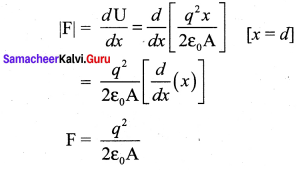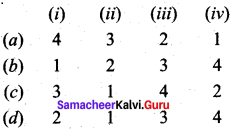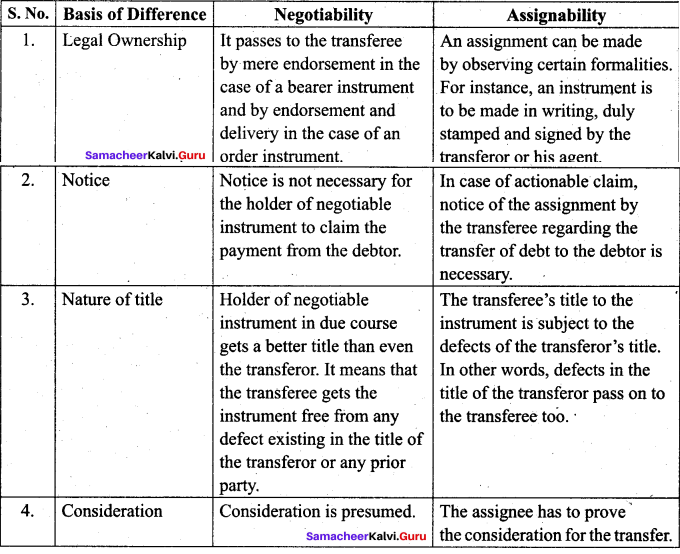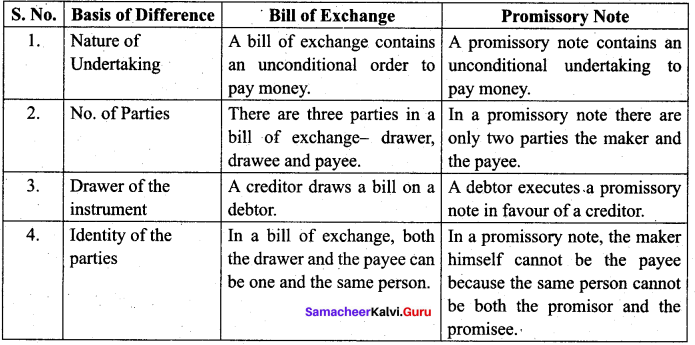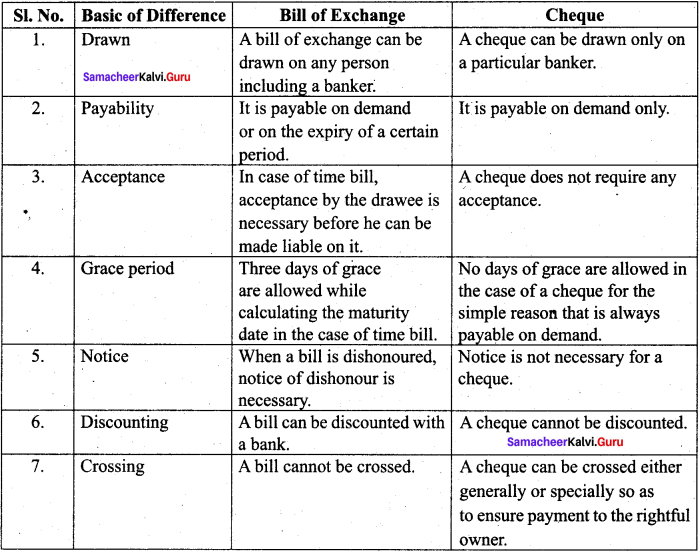Samacheer Kalvi 12th Physics Solutions Chapter 1 Electrostatics
Students can Download Physics Chapter 1 Electrostatics Questions and Answers, Notes Pdf, Samacheer Kalvi 12th Physics Solutions Guide Pdf helps you to revise the complete Tamilnadu State Board New Syllabus and score more marks in your examinations.
Tamilnadu Samacheer Kalvi 12th Physics Solutions Chapter 1 Electrostatics
Samacheer Kalvi 12th Physics Electrostatics Textual Evaluation Solved
Samacheer Kalvi 12th Physics Electrostatics Multiple Choice Questions
Question 1.
Two identical point charges of magnitude -q are fixed as shown in the figure below. A third charge +q is placed midway between the two charges at the point P. Suppose this charge +q is displaced a small distance from the point P in the directions indicated by the arrows, in which direction(s) will +q be stable with respect to the displacement?

(a) A1 and A2
(b) B1 and B2
(c) both directions
(d) No stable
Answer:
(b) B1 and B2
Question 2.
Which charge configuration produces a uniform electric field?
(a) point charge
(b) the infinite uniform line charge
(c) uniformly charged infinite plane
(d) uniformly charged spherical shell
Answer:
(c) uniformly charged infinite plane
Question 3.
What is the ratio of the charges \(\left|\frac{q_{1}}{q_{2}}\right|\) for the following electric field line pattern?
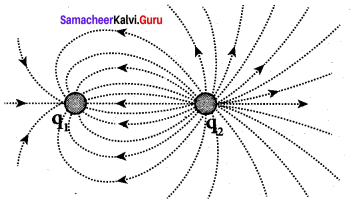
(a) \(\frac { 1 }{ 5 }\)
(b) \(\frac { 25 }{ 11 }\)
(c) 5
(d) \(\frac { 12 }{ 25}\)
Answer:
(d) \(\frac { 12 }{ 25}\)
Question 4.
An electric dipole is placed at an alignment angle of 30° with an electric field of 2 x 105 N C-1. It experiences a torque equal to 8 N m. The charge on the dipole if the dipole length is 1 cm is-
(a) 4 mC
(b) 8 mC
(c) 5 mC
(d) 1 mC
Answer:
(b) 8 mC
![]()
Question 5.
Four Gaussian surfaces are given below with charges inside each Gaussian surface. Rank the electric flux through each Gaussian surface in increasing order-
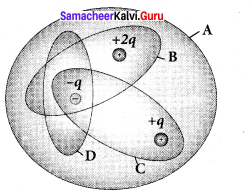
(a) D < C < B < A
(b) A < B = C < D
(c) C < A = B < D
(d)D > C > B > A
Answer:
(a) D < C < B < A
Question 6.
The total electric flux for the following closed surface which is kept inside water-
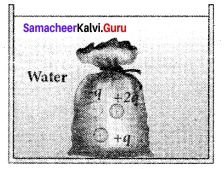
(a) \(\frac { 80q }{{ ε }_{0}}\)
(b) \(\frac { q }{{ 40ε }_{0}}\)
(c) \(\frac { q }{{ 80ε }_{0}}\)
(d) \(\frac { q }{{ 40ε }_{0}}\)
Answer:
(b) \(\frac { q }{{ 40ε }_{0}}\)
Question 7.
Two identical conducting balls having positive charges q1 and q2 are separated by a center to center distance r. If they are made to touch each other and then separated to the same distance, the force between them will be- (NSEP 04-05)
(a) less than before
(b) same as before
(c) more than before
(d) zero
Answer:
(c) more than before
Question 8.
Rank the electrostatic potential energies for the given system of charges in increasing order

(a) 1 = 4 < 2 < 3
(b) 2 = 4 < 3 < 1
(c) 2 = 3 < 1 < 4
(d) 3 < 1 < 2 < 4
Answer:
(a) 1 = 4 < 2 < 3
Question 9.
An electric field \(\vec { E } \) = 10x\(\hat{i} \) exists in a certain region of space. Then the potential difference V = V0 – VA, Where V0 is the potential at the origin and VA is the potential at x = 2 m is-
(a) 10 J
(b) -20 J
(c) + 20 J
(d) – 10 J
Answer:
(a) 10 J
Question 10.
A thin conducting spherical shell of radius R has a charge Q which is uniformly distributed on its surface. The correct plot for electrostatic potential due to this spherical shell is-
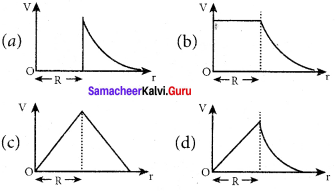
Answer:

Question 11.
Two points A and B are maintained at a potential of 7 V and -4 V respectively. The work done in moving 50 electrons from A to B is-
(a) 8.80 x 10-17 J
(b) -8.80 x 10-17 J
(c) 4.40 x 10-17 J
(d) 5.80 x 10-17 J
Answer:
(a) 8.80 x 10-17 J
![]()
Question 12.
If voltage applied on a capacitor is increased from V to 2V, choose the correct conclusion.
(a) Q remains the same, C is doubled
(b) Q is doubled, C doubled
(c) C remains same, Q doubled
(d) Both Q and C remain same
Answer:
(c) C remains same, Q doubled
Question 13.
A parallel plate capacitor stores a charge Q at a voltage V. Suppose the area of the parallel plate capacitor and the distance between the plates are each doubled then which is the quantity that will change?
(a) Capacitance
(b) Charge
(c) Voltage
(d) Energy density
Answer:
(d) Energy density
Question 14.
Three capacitors are connected in a triangle as shown in the figure. The equivalent capacitance between points A and C is
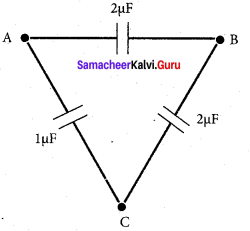
(a) 1 μF
(b) 2 μF
(c) 3 μF
(d) \(\frac { 1 }{ 4 }\) μF
Answer:
(b) 2 μF
Question 15.
Two metallic spheres of radii 1 cm and 3 cm are given charges of -1 x 10-2 C and 5 x 10-2 C respectively. If these are connected by a conducting wire, the final charge on the bigger sphere is (AIIPMT 2012)
(a) 3 x 10-2 C
(b) 4 x 10-2 C
(c) 1 x 10-2 C
(d) 2 x 10-2 C
Answer:
(a) 3 x 10-2 C
Samacheer Kalvi 12th Physics Electrostatics Short Answer Questions
Question 1.
What is meant by quantisation of charges?
Answer:
The charge q on any object is equal to an integral multiple of the fundamental unit of charge ‘e’.
q = ne
Where ‘n’ is an integer e
e = charge of an electron =1.6 × 10-19 C.
Question 2.
Write down Coulomb’s law in vector form and mention what each term represents.
Answer:
The force on a charge q1 exerted by a point charge q1 is given by
\(\vec { F } \)12 = \(\frac { 1 }{{ 4πε }{0}}\) \(\frac {{ q }_{1}{ q }_{2}}{{ r }^{2}}\) \(\hat{r} \)21
Here \(\hat{r} \)21 is the unit vector from charge q1 to q1.
But \(\hat{r} \)21 = –\(\hat{r} \)12,
![]()
Therefore, the electrostatic force obeys Newton’s third law.
Question 3.
What are the differences between the Coulomb force and the gravitational force?
Answer:
| Coulomb force | Gravitational force |
| 1. It can be attractive or repulsive depends on the nature of the charge | 1. It is always attractive |
| 2. The value of Proportionality constant K = 9 x 109 Nm2 C-2 | 2. The value of Gravitational constant G = 6.626 x 1011 Nm2 Kg-2 |
| 3. It depends on the medium which it exists. | 3. It is independent of the medium which it exists. |
![]()
Question 4.
Write a short note on the superposition principle.
Answer:
According to this superposition principle, the total force acting on a given charge is equal to the vector sum of forces exerted on it by all the other charges.
\({ \vec { F } }_{ 1 }^{ tot }\) = \(\vec { F } \)12 + \(\vec { F } \)13 + \(\vec { F } \)14 + \(\vec { F } \)1n
Question 5.
Define ‘Electric field’.
Answer:
It is defined as the force experience by a unit positive charge, kept at that point
It is a Vector quantity.
Unit: NC-1
Question 6.
What is mean by ‘Electric field lines’?
Answer:
Electric field vectors are visualized by the concept of electric field lines. They form a set of continuous lines which are the visual representation of the electric field in some region of space.
Question 7.
The electric field lines never intersect. Justify.
Answer:
If two lines cross at a point, then there will be two different electric field vectors at the same point which is not possible. hence, they do not intersect.
Question 8.
Define ‘Electric dipole’
Answer:
Two equal and opposite charges separated by a small distance constitute an electric dipole.
Question 9.
What is the general definition of electric dipole moment?
Answer:
The electric dipole moment for a collection of ‘n point charges is given by
\(\overrightarrow{\mathrm{P}}=\sum_{i=1}^{\mathrm{n}} \mathrm{q}_{\mathrm{i}} \mathrm{r}_{\mathrm{i}}\)
where r̂i is the position ofvector of change qi from origin.
Question 10.
Define “electrostatic potential”.
Answer:
The electric potential at a point P is equal to the work done by an external force to bring a unit positive charge with constant velocity from infinity to the point P in the region of the external
electric field \(\vec { E } \).
![]()
Question 11.
What is an equipotential surface?
Answer:
An equipotential surface is a surface on which all the points are at the same electric potential.
Question 12.
What are the properties of an equipotential surface?
Answer:
Properties of equipotential surfaces
(i) The work is done to move a charge q between any two points A and B,
W = q (VB – VA). If the points A and B lie on the same equipotential surface, work done is zero because of VA = VB.
(ii) The electric field is normal to an equipotential surface. If it is not normal, then there is a component of the field parallel to the surface. Then work must be done to move a charge between two points on the same surface. This is a contradiction. Therefore the electric field must always be normal to the equipotential surface.
Question 13.
Give the relation between electric field and electric potential.
Answer:
The electric field is the negative gradient of the electric potential.
\(\mathrm{E}=-\frac{\mathrm{d} \mathrm{v}}{\mathrm{d} \mathrm{x}}\)
Question 14.
Define electrostatic potential energy?
Answer:
The potential energy of a system of point charges may be defined as the amount of work done in assembling the charges at their locations by bringing them in from infinity.
Question 15.
Define ‘electric flux’.
Answer:
- The number of electric field lines crossing a given area kept normal to the electric field lines is called electric flux.
- Scalar quantity.
- Unit: Nm2C-1
![]()
Question 16.
What is meant by electrostatic energy density?
Answer:
The energy stored per unit volume of space is defined as energy density uE = \(\frac { U }{ Volume }\)
From equation uE = \(\frac { 1 }{ 2 }\) \(\frac{\left(\varepsilon_{0} A\right)}{d}\) (Ed)2 = \(\frac { 1 }{ 2 }\) ε0 (Ad) E2 or uE = \(\frac { 1 }{ 2 }\) ε0E2
Question 17.
Write a short note on ‘electrostatic shielding’.
Answer:
- The process of isolating a certain region of space from the external field. It is based on the fact that the electric field inside a conductor is zero.
- Whatever the charges at the surfaces and whatever the electrical disturbance outside, the electric field inside the cavity are zero.
Question 18.
What is Polarisation?
Answer:
Polarisation \(\vec { P } \) is defined as the total dipole moment per unit volume of the dielectric.
\(\vec { P } \) = Xe \(\vec { P } \)ext
Question 19.
What is dielectric strength?
Answer:
- The maximum electric field the dielectric can withstand before it breakdowns is called dielectric strength.
- The dielectric strength of air 3 × 106 Vm-1
Question 20.
Define ‘capacitance’. Give its unit.
Answer:
The capacitance C of a capacitor is defined as the ratio of the magnitude of charge on either of the conductor plates to the potential difference existing between the conductors.
C = \(\frac { q }{ V }\) or Q ∝ V.
The SI unit of capacitance is coulomb per volt or farad (F).
Question 21.
What is corona discharge?
Answer:
The total charge of the conductor near the sharp edge gets reduces due to ionization of surrounding air. It is called corona discharge.
Samacheer Kalvi 12th Physics Electrostatics Long Answer Questions
Question 1.
Discuss the basic properties of electric charges.
Answer:
The electric charge is an inherent property of particles.
Conservation of electric charge:
- Total electric charge in the universe is constant.
- Charge can be neither created nor destroyed.
- In any physical process, the net change in charge will always be zero.
- The charge ‘q’ of any object is equal to an integral multiple of the fundamental unit of charge ‘e’.
q = ne - n is any integer
- e is charge of an electron = 1.6 × 10-19C.
Question 2.
Explain in detail Coulomb’s law and its various aspects.
Answer:
Consider two point charges q1 and q2 at rest in vacuum, and separated by a distance of r. According to Coulomb, the force on the point charge q2 exerted by another point charge q1 is
\(\vec { F } \) 21 = K\(\frac{q_{1} q_{2}}{r_{2}}\) \(\hat{r} \)12,
where [/latex] \(\hat{r} \)12 is the unit vector directed from charge q1 to charge q2 and k is the proportionality constant.
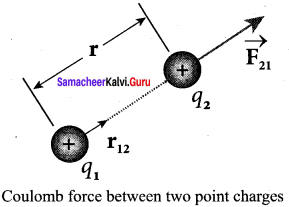
Important aspects of Coulomb’s law:
(i) Coulomb’s law states that the electrostatic force is directly proportional to the product of the magnitude of the two point charges and is inversely proportional to the square of the distance between the two point charges.
(ii) The force on the charge q2exerted by the charge q1 always lies along the line joining the two charges. \(\hat{r} \)21is the unit vector pointing from charge q1 to q2 Likewise, the force on the charge q1 exerted by q2 is along – (i.e., in the direction opposite to \(\hat{r} \)21).
(iii) In SI units, k = \(\frac { 1 }{{ 4πε }_{0}}\) and its value is 9 x 109 Nm2C-2. Here e0 is the permittivity of free space or vacuum and the value of ε0 = \(\frac { 1 }{{ 4πε }_{0}}\) = 8.85 x 10-12 C2 N-1 m-2
(iv) The magnitude of the electrostatic force between two charges each of one coulomb and separated by a distance of 1 m is calculated as follows:
[F] = \(\frac{9 \times 10^{9} \times 1 \times 1}{1^{2}}\) = 9 x 109N. This is a huge quantity, almost equivalent to the weight of one million ton. We never come across 1 coulomb of charge in practice. Most of the electrical phenomena in day-to-day life involve electrical charges of the order of pC (micro coulomb) or nC (nano coulomb).
(v) In SI units, Coulomb’s law in vacuum takes the form \(\vec { F } \) 21 = \(\frac { 1 }{{ 4πε }_{0}}\) \(\frac{q_{1} q_{2}}{r_{2}}\) \(\hat{r} \)12. sin Since ε > ε0, the force between two point charges in a medium other than vacuum is always less than that in vacuum. We define the relative permittivity for a given medium as ε = \(\frac { ε }{{ ε }_{0}}\) .For vacuum or air, εr = 1 and for all other media εr > 1
(vi) Coulomb’s law has same structure as Newton’s law of gravitation. Both are inversely proportional to the square of the distance between the particles. The electrostatic force is directly proportional to the product of the magnitude of two point charges and gravitational force is directly proportional to the product of two masses.
(vii) The force on a charge q1 exerted by a point charge q2 is given by \(\vec { F } \)12 = \(\frac { 1 }{{ 4πε }_{0}}\) \(\frac{q_{1} q_{2}}{r_{2}}\) \(\hat{r} \)12 Here \(\hat{r} \)21 is sthe unit vector from charge q2 to q1.
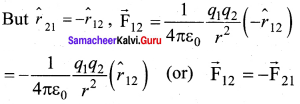
Therefore, the electrostatic force obeys Newton’s third law.
(viii) The expression for Coulomb force is true only for point charges. But the point charge is an ideal concept. However we can apply Coulomb’s law for two charged objects whose sizes are very much smaller than the distance between them. In fact, Coulomb discovered his law by considering the charged spheres in the torsion balance as point charges. The distance between the two charged spheres is much greater than the radii of the spheres.
![]()
Question 3.
Define ‘Electric field’ and discuss its various aspects.
Answer:
The electric field at the point P at a distance r from the point charge q is the force experienced by a unit charge and is given by

Here \(\hat{r} \) is the unit vector pointing from q to the point of interest P. The electric field is a vector quantity and its SI unit is Newton per Coulomb (NC-1).
Important aspects of the Electric field:
(i) If the charge q is positive then the electric field points away from the source charge and if q is negative, the electric field points towards the source charge q.
(ii) If the electric field at a point P is \(\vec { E } \), then the force experienced by the test charge qo placed at the point P is \(\vec { F } \) = q0 \(\vec { E } \). This is Coulomb’s law in terms of the electric field. This is shown below Figure.
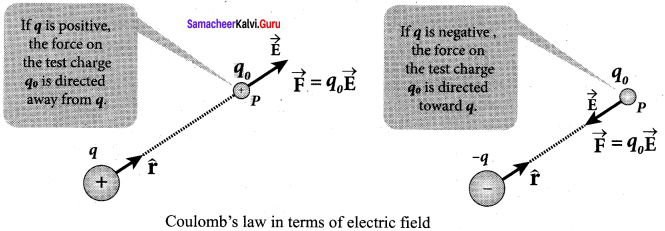
(iii) The equation implies that the electric field is independent of the test charge q0 and it depends only on the source charge q.
(iv) Since the electric field is a vector quantity, at every point in space, this field has a unique direction and magnitude as shown in Figures (a) and (b). From the equation, we can infer that as distance increases, the electric field decreases in magnitude. Note that in Figures (a) and (b) the length of the electric field vector is shown for three different points. The strength or magnitude of the electric field at point P is stronger than at the point Q and R because the point P is closer to the source charge.
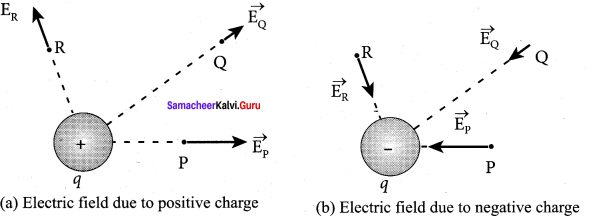
(v) In the definition of the electric field, it is assumed that the test charge q0 is taken sufficiently small, so that bringing this test charge will not move the source charge. In other words, the test charge is made sufficiently small such that it will not modify the electric field of the source charge.
(vi) The expression is valid only for point charges. For continuous and finite-size charge distributions, integration techniques must be used. However, this expression can be used as an approximation for a finite-sized charge if the test point is very far away from the finite-sized source charge.
(vii) There are two kinds of electric field: uniform (constant) electric field and non-uniform electric field. A Uniform electric field will have the same direction and constant magnitude at all points in space. The non-uniform electric field will have different directions or different magnitudes or both at different points in space. The electric field created by a point charge is basically a non-uniform electric field. This non-uniformity arises, both in direction and magnitude, with the direction being radially outward (or inward), and the magnitude changes as distance increases.

Question 4.
How do we determine the electric field due to a continuous charge distribution? Explain. Electric field due to continuous charge distribution.
Answer:
The electric charge is quantized microscopically. The expressions of Coulomb’s Law, superposition principle force and electric field are applicable to only point charges. While dealing with the electric field due to a charged sphere or a charged wire etc., it is very difficult to look at individual charges in these charged bodies. Therefore, it is assumed that charge is distributed continuously on the charged bodies, and the discrete nature of charges is not considered here. The electric field due to such continuous charge distributions is found by invoking the method of calculus.
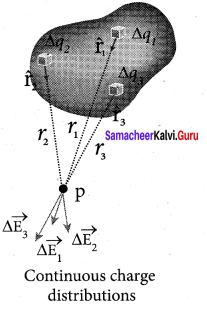
Consider the following charged object of irregular shape. The entire charged object is divided into a large number of charge elements ∆q1, ∆q2, ∆q3 ……..∆qn,…… and each charge element Δq is taken as a point charge.
The electric field at a point P due to a charged object is approximately given by the sum of the fields at P due to all such charge elements.

Here ∆ qi is the ith charge element, rip is the distance of the point P frome the ith charge element, rip is the unit vector from ith charge element to the pont P.
However the equation is only an approximation. To incorporate the continuous distribution of charge, we take the limit ∆q → 0(= dq). In this limit, the summation in the equation becomes an integration and takes the following form
![]()
Here r is the distance of the point P from the infinitesimal charge dq and \(\hat{r} \) is the unit vector from dq to point P. Even though the electric field for a continuous charge distribution is difficult to evaluate, the force experienced by some test charge q in this electric field is still given by \(\vec { F } \) = q\(\vec { E } \).
(a) Line charge distribution: If the charge Q is uniformly distributed along the wire of length L, then linear charge density (charge per unit length) is λ = \(\frac { Q }{ L }\). Its unit is colomb per meter (Cm-1). The charge present in the infinitestimal length dl is dq = λdl.
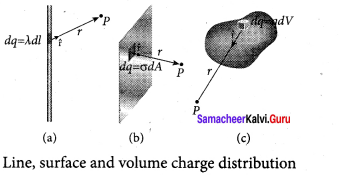
The electric field due to the line of total charge Q is given by

(b) Surface charge distribution: If the charge Q is uniformly distributed on a surface of area A, then surface charge density (charge per unit area) is σ = \(\frac { Q }{ A }\). Its unit is coulomb per square meter (C m-2). The charge present in the infinitesimal area dA is dq = σdA. The electric field due to a of total charge Q is given by

(c) Volume charge distribution: If the charge Q is uniformly distributed in a volume V, then volume charge density (charge per unit volume) is given by ρ = \(\frac { Q }{ V }\). Its unit is coulomb per cubic meter (Cm-3) The charge present in the infinitesimal volume element dV is dq = ρdV. The electric field due to a volume of total charge Q is given by

Question 5.
Calculate the electric field due to a dipole on its axial line and the equatorial plane.
Answer:
Case (I) :
Electric field due to an electric dipole at points on the axial line. Consider an electric dipole placed on the x-ax is as shown in the figure. A point C is located at a distance of r from the midpoint O of the dipole along the axial line. Axial line
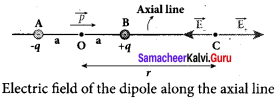
The electric field at a point C due to +q is

Since the electric dipole moment vector \(\vec { P } \) is from -q to +q and is directed along BC, the above equation is rewritten as

where \(\hat{p} \) is the electric dipole moment unit vector from -q to +q. The electric field at a point C due to -q is

Since +q is located closer to the point C than -q, \(\vec { E } \) _. \(\vec { E } \) + us stronger than \(\vec { E } \). Therefore, the length of the E + vector is drawn large than that of \(\vec { E } \) _vector.
The total electric field at point C is calculated using the superposition principle of the electric field.
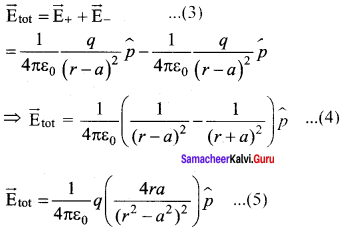
Note that the total electric field is along \(\vec { E } \)+, since +q is closer to C than -q.

The direction of \(\vec { E } \)tot is shown in Figure
If the point C is very far away from the dipole then (r >> a). Under this limit the term(r2 – a2)2 ≈ r4 Substituting this into equation, we get
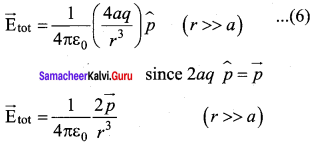
If point C is chosen on the left side of the dipole, the total electric field is still in the
Case (II) :
Electric field due to an electric dipole at a point on the equatorial plane
Consider a point C at a distance r from the midpoint O of the dipole on the equatorial plane as shown in Figure. Since point C is equidistant from +q and -q, the magnitude of the electric fields of +q and -q are the same. The direction of E+ is along with BC and the direction of E is along with CA. E+ and E_ are resolved into two components; one component parallel to the dipole axis and the other perpendicular to it.
The perpendicular components \(\left|\vec{E}_{+}\right|\) sin θ and \(\left|\vec{E}_{-}\right|\) sin θ are oppositely directed and cancel each other. The magnitude of the total electric field at point C is the sum of the paralle component of \(\vec { E } \)+ and \(\vec { E } \)– and its direction is along \(\hat{-p} \).
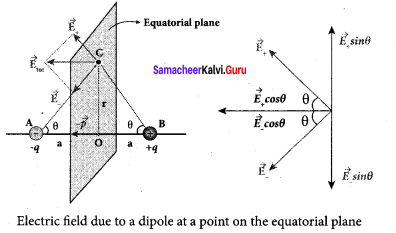
![]()
The magnitudes \(\vec { E } \)+ and \(\vec { E } \)– are the same and are given by

By substituting equation (1) into equation (2), we get
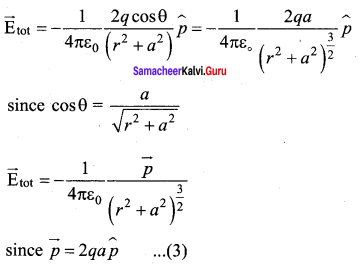
At very large distances (r >> a), the equation becomes
\(\vec { E } \)tot \(\frac { 1 }{{ 4πε }_{0}}\) \(\frac { p }{{ r }^{3}}\) (r >>) …… (4)
![]()
Question 6.
Derive an expression for the torque experienced by a dipole due to a uniform electric field.
Answer:
Torque experienced by an electric dipole in the uniform electric field:
Consider an electric dipole of dipole moment \(\vec { p } \) placed in a uniform electric field E whose field lines are equally spaced and point in the same direction. The charge +q will experience a force q\(\vec { E } \) in the direction of the field and charge -q will experience a force -q\(\vec { E } \) in a direction opposite to the field.
Since the external field \(\vec { E } \) is uniform, the total force acting on the dipole is zero. These two forces acting at different points will constitute a couple and the dipole experience a torque. This torque tends to rotate the dipole. (Note that electric field lines of a uniform field are equally spaced and point in the same direction). The total torque on the dipole about the point O
\(\vec { τ } \) = \(\overrightarrow{\mathrm{OA}}\) × (-q\(\vec { E } \)) + \(\overrightarrow{\mathrm{OB}}\) × q\(\vec { E } \)
Using the right-hand corkscrew rule, it is found that total torque is perpendicular to the plane of the paper and is directed into it.
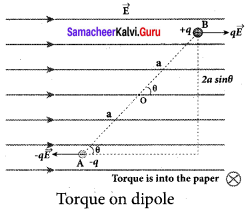
The magnitude of the total torque
\(\vec { τ } \) = \(|\overrightarrow{\mathrm{OA}}|\)(-q\(\vec { E } \)) sin θ + \(|\overrightarrow{\mathrm{OB}}|\) \(|q \overrightarrow{\mathrm{E}}|\) sin θ
where θ is the angle made by \(\vec { P } \) with \(\vec { E } \). Since p = 2aq, the torque is written in terms of the vector product as
\(\vec { τ } \) = \(\vec { p } \) x \(\vec { E } \)
The magnitude of this torque is τ = pE sin θ and is maximum Torque on dipole
when θ =90°.
This torque tends to rotate the dipole and align it with the electric field \(\vec { E } \). Once \(\vec { E } \) is aligned with \(\vec { E } \), the total torque on the dipole becomes zero.
Question 7.
Derive an expression for electrostatic potential due to a point charge.
Answer:
Electric potential due to a point charge:
Consider a positive charge q kept fixed at the origin. Let P be a point at distance r from the charge q.
The electric potential at point P is


Electric field due to positive point charge q is

The infinitesimal displacement vector, d\(\vec { r } \) = dr\(\hat{r} \) and using \(\hat{r} \) . \(\hat{r} \) = 1, we have

After the integration,

Hence the electric potential due to a point charge q at a distance r is
V = \(\frac { 1 }{{ 4πε }_{0}}\) \(\frac { q }{ r }\) …… (2)
Important points (If asked in the exam)
(i) If the source charge q is positive, V > 0. If q is negative, then V is negative and equal to
V = \(\frac { 1 }{{ 4πε }_{0}}\) \(\frac { q }{ r }\)
(ii) The description of the motion of objects using the concept of potential or potential energy is simpler than using the concept of field.
(iii) From expression (2), it is clear that the potential due to positive charge decreases as the distance increases, but for a negative charge, the potential increases as the distance are increased. At infinity (r = ∞) electrostatic potential is zero (V = 0).
(iv) The electric potential at a point P due to a collection of charges q1,q2,q3… qn is equal to the sum of the electric potentials due to individual charges.

Where r1, r2,r3,…..rn are the distances of q1,q2,q3… qn
respectively from P
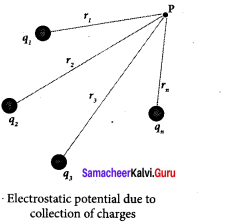
Question 8.
Derive an expression for electrostatic potential due to an electric dipole.
Answer:
Electrostatic potential at a point due to an electric dipole:
Consider two equal and opposite charges separated by a small distance 2a. The point P is located at a distance r from the midpoint of the dipole. Let 0 be the angle between the line OP and dipole axis AB.
Let r1 be the distance of point P from +q and r1 be the distance of point P from -q.
Potential at P due to charge +q = \(\frac { 1 }{{ 4πε }_{0}}\) \(\frac { q }{{ r }_{1}}\)
Potential at P due to charge -q = \(\frac { 1 }{{ 4πε }_{0}}\) \(\frac { q }{{ r }_{2}}\)
Total Potential at the point P,
V = \(\frac { 1 }{{ 4πε }_{0}}\)q \(\left(\frac{1}{r_{1}}-\frac{1}{r_{2}}\right)\) ….. (1)
Suppose if the point P is far away from the dipole, such that r >> a, then equation can be expressed in terms of r. By the cosine law for triangle BOP,
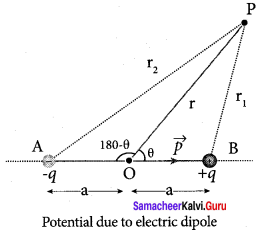
\(r_{1}^{2}\) = r2 + a2 – 2ra cos θ = r2 \(\left(1+\frac{a^{2}}{r^{2}}-\frac{2 a}{r} \cos \theta\right)\)
Since the point P is very far from dipole, then r >> a. As a result the term \(\frac {{ a }^{ 2 }}{{ r }^{ 2 }}\) is very small and can be neglected. Therefore

since \(\frac { a }{ r }\) << 1, we can use binominal theorem and retain the terms up to first order
\(\frac { 1 }{{ r_{1}} }\) = \(\left(1+\frac{a}{r} \cos \theta\right)\) ……. (2)
Similarly applying the cosine law for triangle AOP,
\(r_{2}^{2}\) = r2 + a2 – 2ra cos (180 – θ)
Since cos (180 – θ) = cos θ we get
\(r_{2}^{2}\) = r2 + a2 + 2ra cos θ
Neglecting the term \(\frac {{ a }^{ 2 }}{{ r }^{ 2 }}\) (because r >> a)
\(r_{2}^{2}\) = r2 \(\left(1+\frac{2 a \cos \theta}{r}\right)\) (or) r2 = r \(\left(1+\frac{2 a \cos \theta}{r}\right)^{\frac{1}{2}}\)
Using Binomial theorem, we get
\(\frac { 1 }{{ r_{2}} }\) = \(\frac { 1 }{ r }\) \(\left(1-a \frac{\cos \theta}{r}\right)\)
Substituting equations (3) and (2) in equation (1)
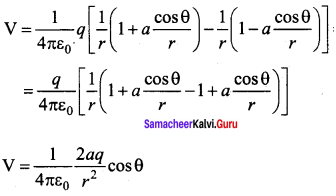
But the electric dipole moment p = 2qa and we get,
V = \(\frac { 1 }{{ 4πε }_{0}}\) \(\left(\frac{p \cos \theta}{r^{2}}\right)\)
Now we can write p cos θ = \(\vec { P } \), \(\hat{r} \) where \(\hat{r} \) is the unit vector from the point O to point P. Hence the electric potential at a point P due to an electric dipole is given by
V = \(\frac { 1 }{{ 4πε }_{0}}\) \(\frac{\vec{p} \cdot \hat{r}}{r^{2}}\) (r >> a) ….. (4)
Equation (4) is valid for distances very large compared to the size of the dipole. But for a point dipole, the equation (4) is valid for any distance.
Special cases:
Case (I):
If the point P lies on the axial line of the dipole on the side of +q, then θ = 0. Then the electric potential becomes
V = \(\frac { 1 }{{ 4πε }_{0}}\) \(\frac { p }{{r}^{ 2 }}\)
Case (II):
If the point P lies on the axial line of the dipole on the side of -q, then θ = 180°, then
V = – \(\frac { 1 }{{ 4πε }_{0}}\) \(\frac { p }{{r}^{ 2 }}\)
Case (III):
If the point P lies on the equatorial line of the dipole, then θ = 90°. Hence, V = 0.
Question 9.
Obtain an expression for potential energy due to a collection of three-point charges which are separated by finite distances.
Answer:
Electrostatic potential energy for a collection of point charges:
The electric potential at a point at a distance r from point charge ql is given by
V = \(\frac { 1 }{{ 4πε }_{0}}\) \(\frac {{ q }_{ 1 }}{r}\) …… (1)
This potential V is the work done to bring a unit positive charge from infinity to the point. Now if the charge q2 is brought from infinity to that point at a distance r from qp the work done is the product of q2 and the electric potential at that point. Thus we have W = q2V …… (2)
This work done is stored as the electrostatic potential energy U of a system of charges q1 and q2 separated by a distance r. Thus we have
U = q2 V = \(\frac { 1 }{{ 4πε }_{0}}\) \(\frac{q_{1} q_{2}}{r}\) …… (3)
The electrostatic potential energy depends only on the distance between the two point charges. In fact, the expression (3) is derived by assuming that q1 is fixed and q2 is brought from infinity. The equation (3) holds true when q2 is fixed and q1 is brought from infinity or both q2and q2 are simultaneously brought from infinity to a distance r between them.
Three charges are arranged in the following configuration as shown in Figure.
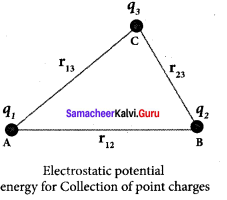
To calculate the total electrostatic potential energy, we use the following procedure. We bring all the charges one by one and arrange them according to the configuration.
(i) Bringing a charge q1 from infinity to point A requires no work, because there are no other charges already present in the vicinity of charge q1
(ii) To bring the second charge q2 to point B, work must be done against the electric field created by the charge q1 So the work done on the charge q1 is W = q2V1B. Here V1B is the electrostatic potential due to the charge q1 at point B.
U = \(\frac { 1 }{{ 4πε }_{0}}\) \(\frac{q_{1} q_{2}}{{r}_{12}}\) ….. (4)
Note that the expression is the same when q2 is brought first and then q1 later.
(iii) Similarly to bring the charge q3 to point C, work has to be done against the total electric field due to both charges q1 and q2. So the work done to bring the charge q3 is = q3 (V1C + V2C). Here V1C is the electrostatic potential due to charge q1 at point C and V2C is the electrostatic potential due to charge q2 at point C. The electrostatic potential is

(iv) Adding equations (4) and (5), the total electrostatic potential energy for the system of three charges q1,q2, and q3 is

Note that this stored potential energy U is equal to the total external work done to assemble the three charges at the given locations. The expression (6) is the same if the charges are brought to their positions in any other order. Since the Coulomb force is a conservative force, the electrostatic potential energy is independent of the manner in which the configuration of charges is arrived at.
![]()
Question 10.
Derive an expression for the electrostatic potential energy of the dipole in a uniform electric field.
Answer:
The electrostatic potential energy of a dipole in a uniform electric field:
Consider a dipole placed a torque when kept in an uniform electric field \(\vec { E } \). A dipole experiences a torque when kept in an uniform electric field \(\vec { E } \). This torque rotates the dipole to align it with the direction of the electric field. To rotate the dipole (at constant angular velocity) from its initial angle θ’ to another angle θ against the torque exerted by the electric field, an equal and opposite external torque must be applied on the dipole.
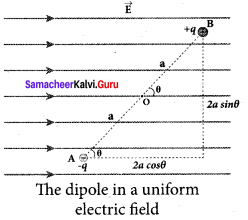
The work done by the external torque to rotate the dipole from angle θ’ to θ at constant angular velocity is

Since τext is equal and opposite to τE = \(\vec { P } \) x \(\vec { E } \), we have
\(\left|\overrightarrow{\mathrm{r}}_{\mathrm{ext}}\right|\) = \(\left|\overrightarrow{\mathrm{r}}_{\mathrm{E}}\right|\)= \(|\overrightarrow{\mathrm{P}} \times \overrightarrow{\mathrm{E}}|\) …. (2)
Substituting equation (2) in equation (1) We get,

This work done is equal to the potential energy difference between the angular positions θ and θ’.
U(θ) – (Uθ’) = AU = -pE cos θ +PE cos θ’.
If the initial angle is = θ’ = 90° and is taken as reference point, then U(θ’) + pE cos θ’ = θ.
The potential energy stored in the system of dipole kept in the uniform electric field is given by El = -pE cos θ = –\(\vec { P } \) . \(\vec { E } \) ….. (3)
In addition to p and E, the potential energy also depends on the orientation θ of the electric dipole with respect to the external electric field.
The potential energy is maximum when the dipole is aligned anti-parallel (θ = π) to the external electric field and minimum when the dipole is aligned parallel (θ = 0) to the external electric field.
Question 11.
Obtain Gauss law from Coulomb’s law.
Answer:
Gauss law: Gauss’s law states that if a charge Q is enclosed by an arbitrary closed surface, then the total electric flux ΦE through the closed surface is
ΦE = \(\oint { \vec { E } } \) .d \(\vec { A } \) = \(\frac{\mathrm{Q}_{\mathrm{end}}}{\varepsilon_{0}}\)
A positive point charge Q is surrounded by an imaginary sphere of radius r as shown in the figure. We can calculate the total electric flux through the closed surface of the sphere using the equation.
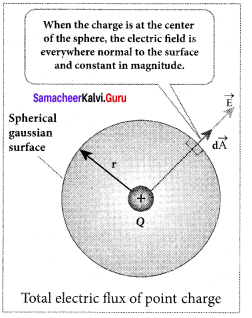
ΦE = \(\oint { \vec { E } } \) .d \(\vec { A } \) = \(\oint { EdA } \) cos θ …… (1)
The electric field of the point charge is directed radially outward at all points on the surface of the sphere. Therefore, the direction of the area element d \(\vec { A } \) is along the electric field \(\vec { E } \) and θ = 0°.
ΦE = \(\oint { EdA } \) since cos 0° = 1 ….. (2)
E is uniform on the surface of the sphere,
ΦE = \(\oint { EdA } \) ….. (3)
Substituting for
\(\oint { dA } \) = 4π2 and E = \(\frac { 1 }{{ 4πε }_{0}}\) Q in equation 3, we get
ΦE = \(\frac { 1 }{{ 4πε }_{0}}\) \(\frac { q }{{ r }^{2}}\) × 4π2 = 4π \(\frac { 1 }{{ 4πε }_{0}}\) = \(\frac { q }{{ ε }_{0}}\) ……. (4)
The equation (4) is called as Gauss’s law. The remarkable point about this result is that the equation (4) is equally true for any arbitrary shaped surface which encloses the charge Q.
Question 12.
Obtain the expression for electric field due to an infinitely long charged wire.
Answer:
Electric field due to an infinitely long charged wire:
Consider an infinitely long straight wire having uniform linear charge density λ. Let P be a point located at a perpendicular distance r from the wire. The electric field at the point P can be found using Gauss law. We choose two small charge elements A1 and A1 on the wire which are at equal distances from the point P.
The resultant electric field due to these two charge elements points radially away from the charged wire and the magnitude of electric field is same at all points on the circle of radius r. From this property, we can infer that the charged wire possesses a cylindrical symmetry.
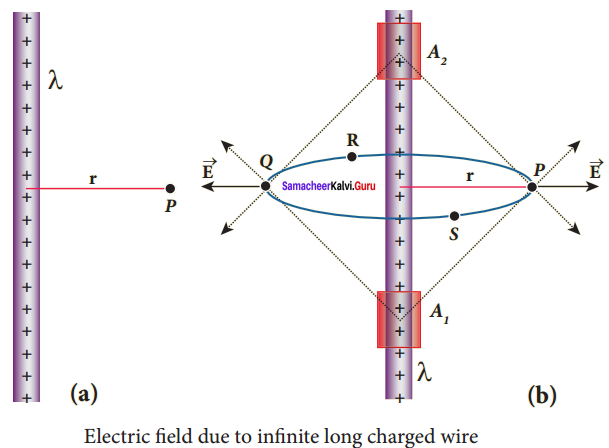
Let us choose a cylindrical Gaussian surface of radius r and length L. The total electric flux in this closed surface is

It is seen that for the curved surface, \(\vec { E } \) is parallel to \(\vec { A } \) and \(\vec { E } \).d \(\vec { A } \) = EdA. For the top and bottom surface, \(\vec { E } \) is perpendicular to \(\vec { A } \) and \(\vec { E } \).d\(\vec { A } \) = 0
Substituting these values in equation (2) and applying Gauss law
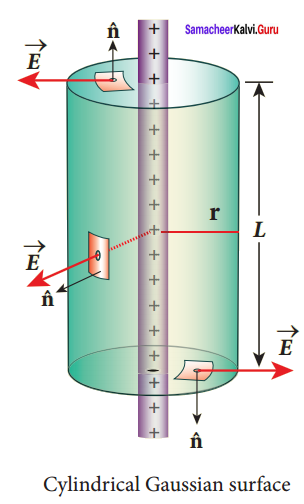

Since the magnitude of the electric field for the entire curved surface is constant, E is taken out of the integration, and Qencl is given by Qencl = λL.

Here,

dA = total area of the curved surface = 2πrL. Substituting this in
equation (4), We get
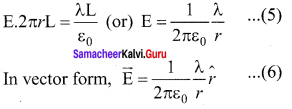
The electric field due to the infinite charged wire depends on \(\frac { 1 }{ r }\) rather than \(\frac { 1 }{{r}^{ 2 }}\) for a point charge.
Equation (6) indicates that the electric field is always along the perpendicular direction (\(\hat{r} \) ) to wire. In fact, if λ > 0 then E points perpendicular outward (\(\hat{r} \) ) from the wire and if λ < 0, then E points perpendicular inward (- \(\hat{r} \) ).
Question 13.
Obtain the expression for the electric field due to a charged infinite plane sheet.
Answer:
Electric field due to the charged infinite plane sheet: Consider an infinite plane sheet of charges with uniform surface charge density o. Let P be a point at a distance of r from the sheet. Since the plane is infinitely large, the electric field should be the same at all points equidistant from the plane and radially directed at all points. A cylindrical shaped Gaussian surface of length 2r and area A of the flat surfaces is chosen such that the infinite plane sheet passes perpendicularly through the middle part of the Gaussian surface.
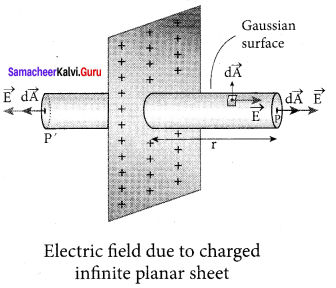
Applying Gauss law for this cylindrical surface,

The electric field is perpendicular to the are element at all points on the curved surface and is parallel to the surface areas at P and P’. Then,

Since the magnitude of the electric field at these two equal surfaces is uniform, E is taken out of the integration, and Qencl is given by Qencl = σA, we get

The total area of surface either at P or P’
![]()
Hence 2EA = \(\frac { σA }{{ ε }_{0}}\) or E = \(\frac { σ }{{ 2ε }_{0}}\) …… (3)
In vector from, E = \(\frac { σ }{{ 2ε }_{0}}\) \(\hat{n} \) ….. (4)
Hence \(\hat{n} \) is the outward unit vector normal to the plane. Note that the electric field due to an infinite plane sheet of the charge depends on the surface charge density and is independent of the distance r.
The electric field will be the same at any point farther away from the charged plane. Equation (4) implies that if o > 0 the electric field at any point P is outward perpendicular n to the plane and if σ < 0 the electric field points inward perpendicularly (\(\hat{n} \) ) to the plane. For a finite charged plane sheet, equation (4) is approximately true only in the middle region of the plane and at points far away from both ends.
![]()
Question 14.
Obtain the expression for the electric field due to a uniformly charged spherical shell.
Answer:
Electric field due to a uniformly charged spherical shell:
Consider a uniformly charged spherical shell of radius R and total charge Q. The electric field at points outside and inside the sphere is found using Gauss law.
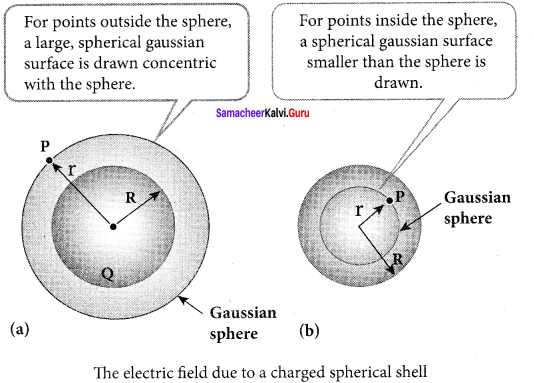
Case (a):
At a point outside the shell (r > R): Let us choose a point P outside the shell at a distance r from the center as shown in figure (a). The charge is uniformly distributed on the surface of the sphere (spherical symmetry). Hence the electric field must point radially outward if Q > 0 and point radially inward if Q < 0. So we choose a spherical Gaussian surface of radius r and the total charge enclosed by this Gaussian surface is Q. Applying Gauss law,
\(\oint { \vec { E } } .d\vec { A } \) = \(\frac { Q }{{ ε }_{0}}\) …….(1)
The electric field \(\vec { E } \) and d\(\vec { A } \) point in the same direction (outward normal) at all the points on the Gaussian surface. The magnitude of \(\vec { E } \) is also the same at all points due to the spherical symmetry of the charge distribution.

But

dA = total area of Gaussian surface = 4πr2. Substituting this value in equation (2).
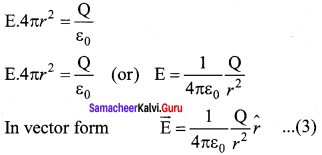
The electric field is radially outward if Q > 0 and radially inward if Q < 0. From equation (3), we infer that the electric field at a point outside the shell will be same as if the entire charge Q is concentrated at the center of the spherical shell. (A similar result is observed in gravitation, for gravitational force due to a spherical shell with mass M)
Case (b):
At a point on the surface of the spherical shell (r = R): The electrical field at points on the spherical shell (r = R) is given by
\(\vec { E } \) = \(\frac{\mathrm{Q}}{4 \pi \varepsilon_{0} \mathrm{R}^{2}}\) \(\hat{r} \) …… (4)
Case (c):
At a point inside the spherical shell (r < R): Consider a point P inside the shell at a distance r from the center. A Gaussian sphere of radius r is constructed as shown in the figure (b). Applying Gauss law
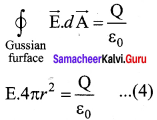
Since Gaussian surface encloses no charge, So Q = 0. The equation (5) becomes E = 0 (r < R) …(6)
The electric field due to the uniformly charged spherical shell is zero at all points inside the shell.
Question 15.
Discuss the various properties of conductors in electrostatic equilibrium.
Answer:
Properties of conductors in electrostatic equilibrium:
(i) The electric field is zero everywhere inside the conductor. This is true regardless of whether the conductor is solid or hollow. This is an experimental fact. Suppose the electric field is not zero inside the metal, then there will be a force on the mobile charge carriers due to this electric field.
As a result, there will be a net motion of the mobile charges, which contradicts the conductors being in electrostatic equilibrium. Thus the electric field is zero everywhere inside – the conductor. We can also understand this fact by applying an external uniform electric field on the conductor.
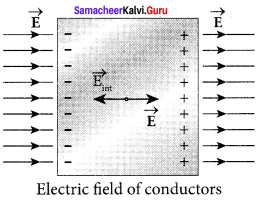
Before applying the external electric field, the free electrons in the conductor are uniformly distributed in the conductor. When an electric field is applied, the free electrons accelerate to the left causing the left plate to be negatively charged and the right plate to be positively charged.
Due to this realignment of free electrons, there will be an internal electric field created inside the conductor which increases until it nullifies the external electric field. Once the external electric field is nullified the conductor is said to be in electrostatic equilibrium. The time taken by a conductor to reach electrostatic equilibrium is in the order of 10-6s, which can be taken as almost instantaneous.
(ii) There is no net charge inside the conductors. The charges must reside only on the surface of the conductors. We can prove this property using Gauss law. Consider an arbitrarily shaped conductor. A Gaussian surface is drawn inside the conductor such that it is very close to the surface of the conductor.
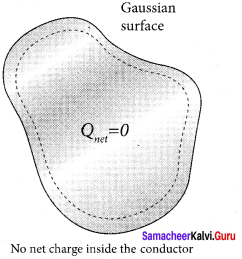
Since the electric field is zero everywhere inside the conductor, the net electric flux is also zero over this Gaussian surface. From Gauss’s law, this implies that there is no net charge inside the conductor. Even if some charge is introduced inside the conductor, it immediately reaches the surface of the conductor.
(iii) The electric field outside the conductor is perpendicular to the surface of the conductor and has a magnitude of \(\frac { σ }{{ ε }{0}}\) where a is the surface charge density at that point. If the electric field has components parallel to the surface of the conductor, then free electrons on the surface of the conductor would experience acceleration. This means that the conductor is not in equilibrium. Therefore at electrostatic equilibrium, the electric field must be perpendicular to the surface of the conductor.
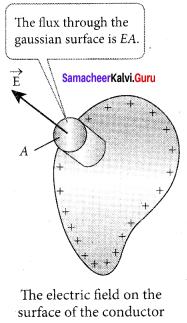
We now prove that the electric field has magnitude \(\frac { σ }{{ ε }{0}}\) just outside the conductor’s surface. Consider a small cylindrical Gaussian surface. One half of this cylinder is embedded inside the conductor. Since electric field is normal to the surface of the conductor, the curved part of the cylinder has zero electric flux. Also inside the conductor, the electric field is zero. Hence the bottom flat part of the Gaussian surface has no electric flux. Therefore the top flat surface alone contributes to the electric flux. The electric field is parallel to the area vector and the total charge inside the surface is σA. By applying Gauss’s law,
EA = \(\frac { σA }{{ ε }{0}}\)
In vector from, \(\vec { E } \) = \(\frac { σ }{{ ε }{0}}\) \(\hat{n} \)
Here n represents the unit vector outward normal to the surface of the conductor. Suppose σ < 0, then electric field points inward perpendicular to the surface.
(iv) The electrostatic potential has the same value on the surface and inside of the conductor. We know that the conductor has no parallel electric component on the surface which means that charges can be moved on the surface without doing any work. This is possible only if the electrostatic potential is constant at all points on the surface and there is no potential difference between any two points on the surface. Since the electric field is zero inside the conductor, the potential is the same as the surface of the conductor. Thus at electrostatic equilibrium, the conductor is always at equipotential.
Question 16.
Explain the process of electrostatic induction.
Answer:
Whenever a charged rod is touched by another conductor, charges start to flow from the charged rod to the conductor. This type of charging without actual contact is called electrostatic induction:
(i) Consider an uncharged (neutral) conducting sphere at rest on an insulating stand. Suppose a negatively charged rod is brought near the conductor without touching it, as shown in figure (a). The negative charge of the rod repels the electrons in the conductor to the opposite side.
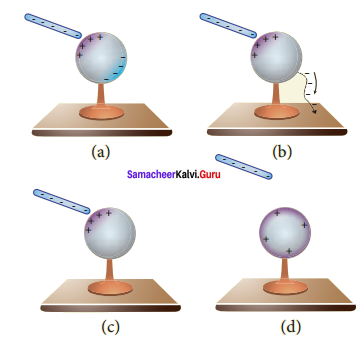
Various steps in electrostatic induction
As a result, positive charges are induced near the region of the charged rod while negative charges on the farther side. Before introducing the charged rod, the free electrons were distributed uniformly on the surface of the conductor and the net charge is zero. Once the charged rod is brought near the conductor, the distribution is no longer uniform with more electrons located on the farther side of the rod and positive charges are located closer to the rod. But the total charge is zero.
(ii) Now the conducting sphere is connected to the ground through a conducting wire. This is called grounding. Since the ground can always receive any amount of electrons, grounding removes the electron from the conducting sphere. Note that positive charges will not flow to the ground because they are attracted by the negative charges of the rod (figure (b)).
(iii) When the grounding wire is removed from the conductor, the positive charges remain near the charged rod (figure (c)).
(iv) Now the charged rod is taken away from the conductor. As soon as the charged rod is removed, the positive charge gets distributed uniformly on the surface of the conductor (figure (d)). By this process, the neutral conducting sphere becomes positively charged.
![]()
Question 17.
Explain dielectrics in detail and how an electric field is induced inside a dielectric.
Answer:
Induced Electric field inside the dielectric:
When an external electric field is applied to a conductor, the charges are aligned in such a way that an internal electric field is created which cancels the external electric field. But in the case of a dielectric, which has no free electrons, the external electric field only realigns the charges so that an internal electric field is produced.
The magnitude of the internal electric field is smaller than that of the external electric field. Therefore the net electric field inside the dielectric is not zero but is parallel to an external electric field with a magnitude less than that of the external electric field. For example, let us consider a rectangular dielectric slab placed between two oppositely charged plates (capacitor) as shown in the figure.
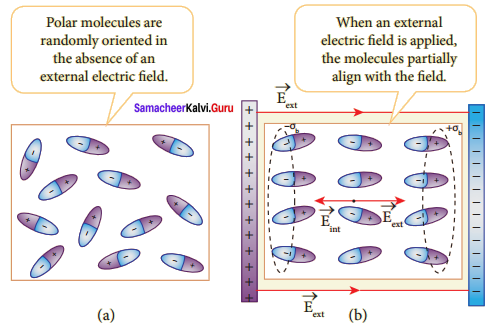
The uniform electric field between the plates Induced electric field lines inside the dielectric acts as an external electric field \(\vec { E } \)ext which polarizes the dielectric placed between plates. The positive charges are induced on one side surface and negative charges are induced on the other side of the surface But inside the dielectric, the net charge is zero even in a small volume. So the dielectric in the external field is equivalent to two oppositely charged sheets with the surface charge densities +σb and -σb. These charges are called bound charges. They are not free to move like free electrons in conductors. This is shown in the figure.
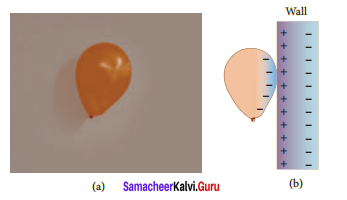
(a) Balloon sticks to the wall
(b) Polarisation of the wall due to the electric field created by the balloon
For example, the charged balloon after rubbing sticks onto a wall. The reason is that the negatively charged balloon is brought near the wall, it polarizes opposite charges on the surface of the wall, which attracts the balloon.
Question 18.
Obtain the expression for capacitance for a parallel plate capacitor.
Answer:
The capacitance of a parallel plate capacitor:
Consider a capacitor with two parallel plates each of cross-sectional area A and separated by a distance d. The electric field between two infinite parallel plates is uniform and is given by E = \(\frac { σ }{{ ε }{0}}\) where σ is the surface charge density on the plates σ = \(\frac { Q }{ A }\) .If the separation distance d is very much smaller than the size of the plate (d2 << A), then the above result is used even for finite-sized
parallel plate capacitor.
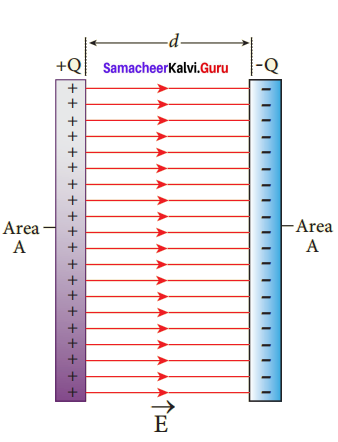
The capacitance of a parallel plate capacitor
The electric field between the plates is
E = \(\frac { Q }{{ Aε }{0}}\) ….. (1)
Since the electric field is uniform, the electric potential between the plates having separation d is given by
V = Ed = \(\frac { Qd }{{ Aε }{0}}\) ….. (2)
Therefore the capacitance of the capacitor is given by
C = \(\frac { Q }{ V }\) = \(\frac{\mathrm{Q}}{\left(\frac{\mathrm{Q} d}{\mathrm{A} \varepsilon_{0}}\right)}\) = \(\frac{\varepsilon_{0} \mathrm{A}}{d}\) ….. (3)
From equation (3), it is evident that capacitance is directly proportional to the area of cross-section and is inversely proportional to the distance between the plates. This can be understood from the following.
- If the area of cross-section of the capacitor plates is increased, more charges can be distributed for the same potential difference. As a result, the capacitance is increased.
- If the distance d between the two plates is reduced, the potential difference between the plates (V = Ed) decreases with the E constant.
Question 19.
Obtain the expression for energy stored in the parallel plate capacitor.
Answer:
Energy stored in the capacitor:
Capacitor not only stores the charge but also it stores energy. When a battery is connected to the capacitor, electrons of total charge -Q are transferred from one plate to the other plate. To transfer the charge, work is done by the battery. This work done is stored as electrostatic potential energy in the capacitor. To transfer an infinitesimal charge dQ for a potential difference V, the work done is given by
dW = VdQ ….. (1)
Where V = \(\frac { Q }{ C }\)
The total work done to charge a capacitor is

This work done is stored as electrostatic potential energy (UE) in the capacitor.
UE = \(\frac {{ Q }^{2}}{ 2C }\) = \(\frac { 1 }{ 2 }\) CV2 (∴ Q = CV) ….. (3)
where Q = CV is used. This stored energy is thus directly proportional to the capacitance of the capacitor and the square of the voltage between the plates of the capacitor. But where is this energy stored in the capacitor? To understand this question, the equation (3) is rewritten as follows using the results
C = \(\frac{\varepsilon_{0} \mathrm{A}}{d}\) and V = Ed
UE = \(\frac { 1 }{ 2 }\) \(\left(\frac{\varepsilon_{0} \mathrm{A}}{d}\right)\) (Ed)2 = \(\frac { 1 }{ 2 }\) ε0(Ad)2 …… (4)
where Ad = volume of the space between the capacitor plates. The energy stored per unit volume of space is defined as energy density \(\overline { Volume } \). Frome equation (4) we get
uE = \(\frac { 1 }{ 2 }\) ε0E2
From equation (5), we infer that the energy is stored in the electric field existing between the plates of the capacitor. Once the capacitor is allowed to discharge, the energy is retrieved.
Question 20.
Explain in detail the effect of a dielectric placed in a parallel plate capacitor.
Answer:
(i) When the capacitor is disconnected from the battery:
Consider a capacitor with two parallel plates each of cross-sectional area A and are separated by a distance d. The capacitor is charged by a battery of voltage V0 and the charge stored is Q0. The capacitance of the capacitor without the dielectric is
C0 = \(\frac {{ Q }_{0}}{{ V }_{0}}\) ….. (1)
The battery is then disconnected from the capacitor and the dielectric is inserted between the plates. The introduction of dielectric between the plates will decrease the electric field. Experimentally it is found that the modified electric field is given by
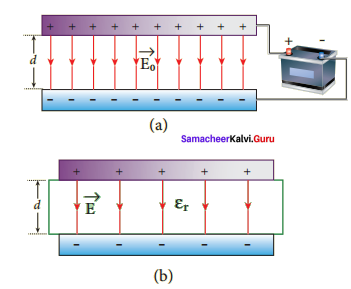
(a) Capacitor is charged with a battery
(b) Dielectric is inserted after the battery is disconnected
E = \(\frac {{ E }_{0}}{{ ε }_{r}}\) …… (2)
Here E0 is the electric field inside the capacitors when there is no dielectric and εr is the relative permeability of the dielectric or simply known as the dielectric constant. Since εr > 1, the electric field E < E0. As a result, the electrostatic potential difference between the plates (V = Ed) is also reduced. But at the same time, the charge Q0 will remain constant once the battery is disconnected. Hence the new potential difference is
V = Ed = \(\frac {{ E }_{0}}{{ ε }_{r}}\)d = \(\frac {{ V }_{0}}{{ ε }_{r}}\) ….. (3)
We know that capacitance is inversely proportional to the potential difference. Therefore as V decreases, C increases. Thus new capacitance in the presence of a dielectric is
C = \(\frac {{ Q }_{0}}{ V }\) = εr \(\frac {{ Q }_{0}}{{ V }_{0}}\) = εr C0 …… (4)
Since εr > 1, we have C > C0. Thus insertion of the dielectric constant εr increases the capacitance. Using equation,
C = \(\frac { { \varepsilon }_{ 0 }A }{ d } \)
C = \(\frac{\varepsilon_{r} \varepsilon_{o} A}{d}\) = \(\frac { εA }{ d }\) …… (5)
where ε = εrε0 is the permittivity of the dielectric medium. The energy stored in the capacitor before the insertion of a dielectric is given by U0 = \(\frac { 1 }{ 2 }\) \(\frac{\mathrm{Q}_{0}^{2}}{\mathrm{C}_{0}}\) ….. (6)
After the dielectric is inserted, the charge Q0 remains constant but the capacitance is increased. As a result, the stored energy is decreased.

Since εr> 1 we get U < U0. There is a decrease in energy because, when the dielectric is inserted, the capacitor spends some energy in pulling the dielectric inside.
(ii) When the battery remains connected to the capacitor: Let us now consider what happens when the battery of voltage V0 remains connected to the capacitor when the dielectric is inserted into the capacitor.
The potential difference V0 across the plates remains constant. But it is found experimentally (first shown by Faraday) that when the dielectric is inserted, the charge stored in the capacitor is increased by a factor εr.
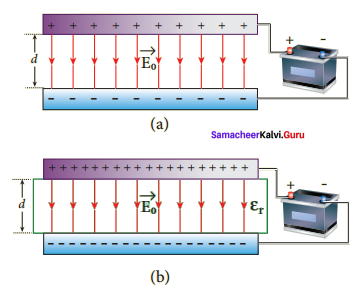
(a) Capacitor is charged through a battery
(b) Dielectric is inserted when the battery is connected.
Q = εrQ0 ….. (1)
Due to this increased charge, the capacitance is also increased. The new capacitance is
C = \(\frac {{ Q }_{0}}{ V }\) = εr \(\frac {{ Q }_{0}}{{ V }_{0}}\) = εr C0 …… (2)
However, the reason for the increase in capacitance in this case when the battery remains connected is different from the case when the battery is disconnected before introducing the dielectric.
Now, C0 = \(\frac {{ ε }{_0}A}{ d }\) and, C = \(\frac { εA }{ d }\) …… (3)
U0 = \(\frac { 1 }{ 2 }\) C0 \({ V }_{ 0 }^{ 2 }\) ….. (4)
Note that here we have not used the expression
U0 = \(\frac { 1 }{ 2 }\)\({{ V }_{ 0 }^{ 2 }}{{C}_{0}}\)
because here, both charge and capacitance are changed, whereas in equation 4, V0 remains constant. After the dielectric is inserted, the capacitance is increased; hence the stored energy is also increased.
U = \(\frac { 1 }{ 2 }\) \({ CV }_{ 0 }^{ 2 }\) = \(\frac { 1 }{ 2 }\) εr \({ CV }_{ 0 }^{ 2 }\) = εr U0
Since er > 1 we have U > U0
It may be noted here that since voltage between the capacitor V0 is constant, the electric field between the plates also remains constant.
Question 21.
Derive the expression for resultant capacitance, when capacitors are connected in series and in parallel.
Answer:
capacitors in series and parallel:
(i) Capacitors in series:
Consider three capacitors of capacitance C1, C2 and C3 connected in series with a battery of voltage V as shown in figure (a).
As soon as the battery is connected to the capacitors in series, the electrons of charge -Q are transferred from the negative terminal to the right plate of C3which pushes the electrons of the same amount -Q from left plate of C3 to the right plate of C2 due to electrostatic induction. Similarly, the left plate of C2 pushes the charges of Q to the right plate of which induces the positive charge +Q on the left plate of C1 At the same time, electrons of charge -Q are transferred from the left plate of C1 to the positive terminal of the battery.
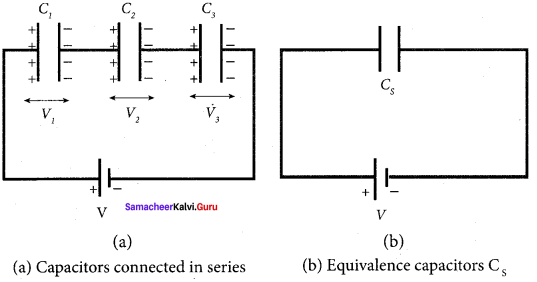
By these processes, each capacitor stores the same amount of charge Q. The capacitances of the capacitors are in general different so that the voltage across each capacitor is also different and are denoted as V1, V2 and V3 respectively.
The total voltage across each capacitor must be equal to the voltage of the battery.
V = V1 + V2 + V3 ….. (1)
Since Q = CV, we have V = \(\frac { Q }{{ C }_{1}}\) + \(\frac { Q }{{ C }_{2}}\) + \(\frac { Q }{{ C }_{3}}\)
Q = \(\left( \frac { 1 }{ { C }_{ 1 } } +\frac { 1 }{ { C }_{ 2 } } +\frac { 1 }{ { C }_{ 3 } } \right) \) ….. (2)
If three capacitors in series are considered to form an equivalent single capacitor Cs shown in figure (b), then we have V = \(\frac { Q }{{ C }_{s}}\)
Substituting this expression into equation (2) we get
V = \(\frac { Q }{{ C }_{s}}\) = Q\(\left( \frac { 1 }{ { C }_{ 1 } } +\frac { 1 }{ { C }_{ 2 } } +\frac { 1 }{ { C }_{ 3 } } \right) \)
\(\frac { 1 }{{ C }_{s}}\) = \(\frac { 1 }{{ C }_{1}}\) + \(\frac { 1 }{{ C }_{2}}\) + \(\frac { 1 }{{ C }_{3}}\) ….. (3)
Thus, the inverse of the equivalent capacitance Cs of three capacitors connected in series is equal to the sum of the inverses of each capacitance. This equivalent capacitance Cs is always less than the smallest individual capacitance in the series.
(ii) Capacitance in parallel:
Consider three capacitors of capacitance C1,C2 and C3 connected in parallel with a battery of voltage V as shown in figure (a).
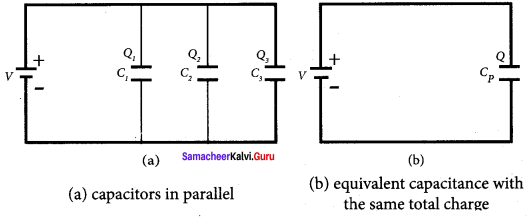
Since corresponding sides of the capacitors are connected to the same positive and negative terminals of the battery, the voltage across each capacitor is equal to the battery’s voltage. Since the capacitance of the capacitors is different, the charge stored in each capacitor is not the same. Let the charge stored in the three capacitors be Q1,Q2, and Q2 respectively. According to the law of conservation of total charge, the sum of these three charges is equal to the charge Q transferred by the battery,
Q = Q1 + Q2 + Q3 ….. (1)
Now, since Q = CV, we have
Q = C1V + C2 V + C3 V ….. (2)
If these three capacitors are considered to form a single capacitance CP which stores the total charge Q as shown in figure (b), then we can write Q = CPV. Substituting this in equation (2), we get
Cp V = C1 V + C2 V + C3 V
Cp = C1 + C2 + C3
Thus, the equivalent capacitance of capacitors connected in parallel is equal to the sum of the individual capacitance. The equivalent capacitance Cp in a parallel connection is always greater than the largest individual capacitance. In a parallel connection, it is equivalent as an area of each capacitance adds to give a more effective area such that total capacitance increases.
Question 22.
Explain in detail how charges are distributed in a conductor, and the principle behind the lightning conductor.
Answer:
Distribution of charges in a conductor: Consider two conducting spheres A and B of radii r1 and r2 respectively connected to each other by a thin conducting wire as shown in the figure. The distance between the spheres is much greater than the radii of either sphere.
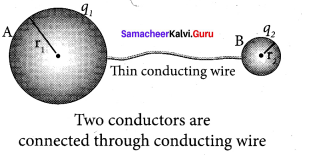
If a charge Q is introduced into any one of the spheres, this charge Q is redistributed into both the spheres such that the electrostatic potential is same in both the spheres. They are now uniformly charged and attain electrostatic equilibrium. Let q1 be the charge residing on the surface of sphere A and q2 is the charge residing on the surface of sphere B such that Q = q1 + q2 The charges are distributed only on the surface and there is no net charge inside the conductor. The electrostatic potential at the surface of sphere A is given by
VA = \(\frac { 1 }{{ 4πε }_{0}}\) \(\frac {{ q }_{ 2 }}{{ r }_{ 2 }}\) …. (1)
The electrostatic potential at the surface of sphere B is given by
VB = \(\frac { 1 }{{ 4πε }_{0}}\) \(\frac {{ q }_{ 2 }}{{ r }_{ 2 }}\) ….. 2)
The surface of the conductor is an equipotential. Since the spheres are connected by the conducting wire, the surfaces of both the spheres together form an equipotential surface. This implies that
VA = VB or \(\frac {{ q }_{ 1 }}{{ r }_{ 1 }}\) = \(\frac {{ q }_{ 2 }}{{ r }_{ 2 }}\) ….. (3)
Let us take the charge density on the surface of sphere A is σ1 and charge density on the surface of sphere B is σ1. This implies that q1 = \({ 4\pi r }_{ 1 }^{ 2 }\)σ1 and q1 = \({ 4\pi r }_{ 1 }^{ 2 }\)σ2. Substituting these values into equation (3), we get
σ1 r1 = σ2r2 ….. (4)
from which we conclude that
σr = constant …. (5)
Thus the surface charge density o is inversely proportional to the radius of the sphere. For a smaller radius, the charge density will be larger and vice versa.
Lightning arrester or lightning conductor:
This is a device used to protect tall buildings from lightning strikes. It works on the principle of action at points or corona discharge. The device consists of a long thick copper rod passing from top of the building to the ground. The upper end of the rod has a sharp spike or a sharp needle.
The lower end of the rod is connected to the copper plate which is buried deep into the ground. When a negatively charged cloud is passing above the building, it induces a positive charge on the spike. Since the induced charge density on thin sharp spike is large, it results in a corona discharge.
This positive charge ionizes the surrounding air which in turn neutralizes the negative charge in the cloud. The negative charge pushed to the spikes passes through the copper rod and is safely diverted to the Earth. The lightning arrester does not stop the lightning; rather it divers the lightning to the ground safely.
![]()
Question 23.
Explain in detail the construction and working of a Van de Graaff generator.
Answer:
Principle: Electrostatic induction and action at points.
Construction:
A large hollow spherical conductor is fixed on the insulating stand. A pulley B is mounted at the center of the hollow sphere and another pulley C is fixed at the bottom. A belt made up of insulating materials as silk or rubber runs over both pulleys. The pulley C is driven continuously by the electric motor.
Two comb-shaped metallic conductors E and D are fixed near the pulleys. The comb D is maintained at a positive potential of 104 V by a power supply. The upper comb E is connected to the inner side of the hollow metal sphere.
Working:
Due to the high electric field near comb D, the air between the belt and comb D gets ionized. The positive charges are pushed towards the belt and negative charges are attracted towards the comb D. The positive charges stick to the belt and move up. When the positive charges reach the comb E, a large amount of negative and positive charges are induced on either side of comb E due to electrostatic induction. As a result, the positive charges are pushed away from the comb E and they reach the outer surface of the sphere. Since the sphere is a conductor, the positive charges are distributed uniformly on the outer surface of the hollow sphere. At the same time, the negative charges nullify the positive charges in the belt due to corona discharge before it passes over the pulley.
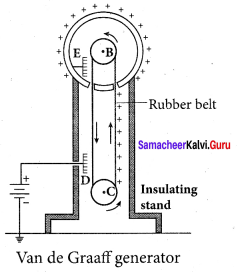
When the belt descends, it has almost no net charge. At the bottom, it again gains a large positive charge. The belt goes up and delivers positive charges to the outer surface of the sphere. This process continues until the outer surface produces the potential difference of the order of 107 which is the limiting value. We cannot store charges beyond this limit since the extra charge starts leaking to the surroundings due to the ionization of air. The leakage of charges can be reduced by enclosing the machine in a gas-filled steel chamber at very high pressure. Uses: The high voltage produced in this Van de Graaff generator is used to accelerate positive ions (protons and deuterons) for nuclear disintegrations and other applications.
Samacheer Kalvi 12th Physics Electrostatics Numerical Problems
Question 1.
When two objects are rubbed with each other, approximately a charge of 50 nC can be produced in each object. Calculate the number of electrons that must be transferred to produce this charge.
Solution:
Charge produced in each object q = 50 nC
q = 50 x 10-9 C
Charge of electron (e) = 1.6 x 10-9 C
Number of electron transferred, n = \(\frac { q }{ e }\) = \(\frac {{ 50 × 10 }^{-9}}{{ 1.6 × 10 }^{-19}}\)
=31. 25 × 10-9 × 1019
n = 31.25 x 1010 electrons
Ans. n = 31.25 x 1010 electrons
Question 2.
The total number of electrons in the human body is typically in the order of 1028. Suppose, due to some reason, you and your friend lost 1% of this number of electrons. Calculate the electrostatic force between you and your friend separated at a distance of 1 m. Compare this with your weight. Assume the mass of each person is 60 kg and use point charge approximation.
Solution:
Number of electrons in the human body = 1028
Number of electrons in me and my friend after lost of 1% = 1028 x 1%
= 1028 x \(\frac { 1 }{ 100 }\)
n = 1026 electrons
Separation distance d = 1 m
Charge of each person q = 1026 x 1.6 x 10-19
q = 1.6 x 107 C
Electrostatic force, F = \(\frac { 1 }{{ 4πε }_{0}}\) \(\frac{q_{1} q_{2}}{r^{2}}\) = \(\frac{9 \times 10^{9} \times 1.6 \times 10^{7} \times 1.6 \times 10^{7}}{1^{2}}\)
F = 2.304 x 1024N
Mass of the person, M = 60 kg
Acceleration due to gravity, g = 9.8 ms-2
Weight (W) = mg
= 60 x 9.8
W = 588 N
Comparison: Electrostatic force is equal to 3.92 x 1021 times of weight of the person.
![]()
Question 3.
Five identical charges Q are placed equidistant on a semicircle as shown in the figure. Another point charge q is kept at the center of the circle of radius R. Calculate the electrostatic force experienced by the charge q.
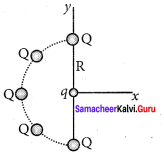
Solution:
Force acting on q due to Q1 and Q5 are opposite direction, so cancel to each other.
Force acting on q due to Q3 is F3 = \(\frac { 1 }{{ 4πε }_{0}}\) \(\frac {{ qQ }_{3}}{{ R }^{2}}\)
Force acting on q due to Q2 and Q4
Resolving in two-component method:
(i) Vertical Component:
Q2 Sin θ and Q4 Sinθ are equal and opposite directions, so they cancel to each other.
(ii) Horizontal Component:
Q2 Sin θ and Q4 cos θ are equal and same direction, so they can get added.
F24 = F2q + F4q = F2 cos 55° + F4 cos 45°
F24 = \(\frac { 1 }{{ 4πε }_{0}}\) \(\frac {{ qQ }_{2}}{{ R }^{2}}\) cos 45° + \(\frac { 1 }{{ 4πε }_{0}}\) \(\frac { qQ 4}{{ R }^{2}}\) cos 45°
Resultant net force F
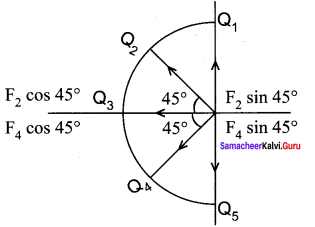
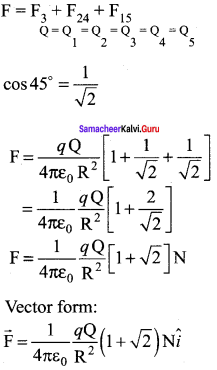
Question 4.
Suppose a charge +q on Earth’s surface and another +q charge is placed on the surface of the Moon, (a) Calculate the value of q required to balance the gravitational attraction between Earth and Moon (b) Suppose the distance between the Moon and Earth is halved, would the charge q change? (Take mE = 5.9 x 1024 kg, mM = 7.348 x 1022 kg)
Solution:
Mass of the Earth, ME = 5.9 x 1024 kg
Mass of the Moon, MM = 7.348 x 1022 kg
Charge placed on the surface of Earth and Moon = q
(a) Required charge to balance the FG between Earth and Moon
FC = FG (or) \(\frac { 1 }{{ 4πε }_{0}}\) \(\frac {{ q }^{2}}{{ r }^{2}}\) = \(\frac{\mathrm{G} \mathrm{M}_{\mathrm{E}} \times \mathrm{M}_{\mathrm{M}}}{r^{2}}\)
q2 = G × ME × MM × 4πε0 = 320.97 × 1025
q = \(\sqrt { 320.97\times { 10 }^{ 25 } } \) = 5.665 x 1013 = 5.67 x 1013 C
(b) The distance between the Moon and Earth is

so q = 5.67 x 1013 C
There is no change.
Question 5.
Draw the free body diagram for the following charges as shown in figure (a), (b) and (c).
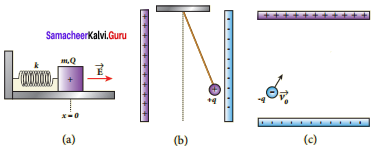
Solution:
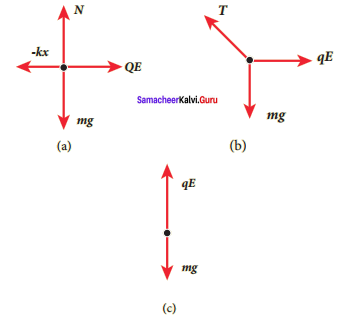
Question 6.
Consider an electron travelling with a speed VΦ and entering into a uniform electric field \(\vec { E } \) which is perpendicular to \(\overrightarrow{\mathrm{V}_{0}}\) as shown in the Figure. Ignoring gravity, obtain the electron’s acceleration, velocity and position as functions of time.
Solution:
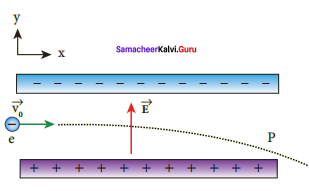
Speed of an electron = V0
Uniform electric field = \(\vec { E } \)
(а) Electron’s acceleration:
Force on electron due to uniform electric field, F = Ee
Downward acceleration of electron due to electric field, a = \(\frac { F }{ m }\) = – \(\frac { eE }{ M }\)
Vector from, \(\vec { a } \) = – \(\frac { eE }{ M }\) \(\hat{j} \)
(b) Electron’s velocity:
Speed of electron in horizontal direction, u = V0 From the equation of motion, V = u + at
V = V0 \(\frac { eE }{ M }\) t
Vector from \(\vec { V } \) = V0 \(\hat{j} \) – \(\frac { eE }{ M }\) t \(\hat{j} \)
(c) Electron’s position:
Position of electron, s = r
From equation of motion, r = V0 t + \(\frac { 1 }{ 2 }\) \(\left(-\frac{e \mathrm{E}}{\mathrm{M}}\right)\) t2
r = V0 t + \(\frac { 1 }{ 2 }\) \(\frac { eE }{ M }\) t2 \(\hat{j} \)
Vector from,
\(\vec { r } \) = V0 t \(\hat{j} \) \(\frac { 1 }{ 2 }\) \(\frac { eE }{ M }\) t2 \(\hat{j} \)
![]()
Question 7.
A closed triangular box is kept in an electric field of magnitude E = 2 × 103 N C-1 as shown in the figure.
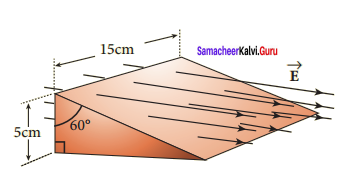
Calculate the electric flux through the
(a) vertical rectangular surface
(b) slanted surface and
(c) entire surface.
Answer:
Electric field of magnitude E = 2 × 103 NC-1
(a) Vertical rectangular surface:
Rectangular area A= 5 × 10-2 × 15 × 10-2
A = 75 × 10-24 m2
θ = 180°
⇒ cos 180° = -1
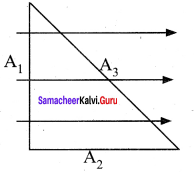
Electric flux, Φv.s = EA cos θ
= 2 × 103 × 75 × 10-4 × cos 180°
= -150 × 10-1
Φv.s = -15 Nm2 C-1
(b) Slanted surface:
cos θ = cos 60° = 0.5
sin θ = sin 30° = \(\frac { Opposite }{ hyp }\)
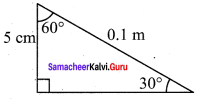
hyp = \(\frac {{ 5 × 10 }^{2}}{ 0.5 }\)
hyp = 0.1m
Area of slanted surface A2 = (0.1 × 15 × 10-2)
A2 = 0.015 M2
Electric flux, Φv.s = EA = cos θ
= 2 × 103 × 0.015 × cos 60°
= 2 × 103 × 0.015 × 103
= 0.015 × 103
Φv.s = 15 Nm2 C-1
Horizontal surface
θ = 90° ; cos 90° = 0
Electric flux, ΦH.S = E. A3 Cos 90° = 0
(c) Entire surface:
ΦTotal = ΦV.S + ΦS.S + ΦH.S = -15 + 15 + 0
ΦTotal = 0
Question 8.
The electrostatic potential is given as a function of x in figure (a) and (b). Calculate the corresponding electric fields in regions A, B, C and D. Plot the electric field as a function of x for the figure (b).
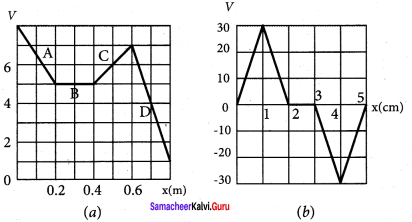
Answer:
The relation between electric field and potential
E = – \(\frac { dv }{ dx }\)
(a) Region A :
dv = -3V ; dx = 0.2 m
Electric field, EA = \(\frac { (-3) }{ 0.2 }\) = 15 V m-1
Region B:
dv = 0V ; dx = 0.2 m
Electric field, EB = \(\frac { 0 }{ 0.2 }\) = 0
Region C:
dv = 2V ; dx = 0.2 m
Electric field, EC = \(\frac { -2 }{ 0.2 }\) = 10 V m-1
Region D:
dv = -6V ; dx = 0.2 m
Electric field, ED = \(-\left(\frac{-6}{0.2}\right)\) = 10 V m-1 = 30 V m-1
Electric field, EA = 15 V m-1
Electric field, EB = 0
Electric field, EC = \(\frac { (-3) }{ 0.2 }\) = 10 V m-1
Electric field, ED = 30 V m-1
(b)
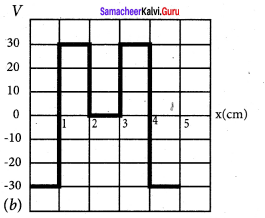
Question 9.
A spark plug in a bike or a car is used to ignite the air-fuel mixture in the engine. It consists of two electrodes separated by a gap of around 0.6 mm gap as shown in the figure.
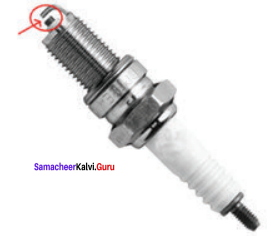
To create the spark, an electric field of magnitude 3 x 106Vm-1 is required, (a) What potential difference must be applied to produce the spark? (b) If the gap is increased, does the potential difference increase, decrease or remains the same? (c) find the potential difference if the gap is 1 mm.
Answer:
Separation gap between two electrodes, d = 0.6 mm
d = 0.6 × 10-3 m
Magnetude of electric field Electric field = E = 3 × 106 V m-1
Electric field E = \(\frac { V }{ d }\)
(a) Applied potential difference, V = E . d
= 3 × 106 × 0.6 10-13 = 1.8 × 103
V = 1800 V
(b) From equation, V = E . d
If the gap (distance) between the electrodes increased, the potential difference also increases.
(c) Gap between the electrodes, d = 1mm = 1 x 10-3 m
Potential difference, V = E.d
= 3 × 106 × 1 × 10-3 = 3 × 103
V = 3000 V
![]()
Question 10.
A point charge of +10 μC is placed at a distance of 20 cm from another identical point charge of +10 μC. A point charge of -2 μC is moved from point a to b as shown in the figure. Calculate the
change in potential energy of the system? Interpret your result.
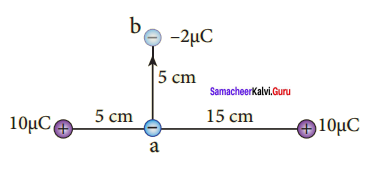
q1 = 10μC = 10 x 10-6 C
q2 = 2μC = -2 x 10-6 C
distance, r = 5cm = 5 x 10-2 m
Answer:
Change in potential energy,

= -36 × 1 × 109 × 10-12 × 102 = -36 × 10-1
∆ U = -3.6 J
Negative sign implies that to move the charge -2pC no external work is required. System spends its stored energy to move the charge from point a to point b.
Ans:
∆ U = -3.6 J, negative sign implies that to move the charge -2μC no external work is required. System spends its stored energy to move the charge from point a to point b.
Question 11.
Calculate the resultant capacitances for each of the following combinations of capacitors.
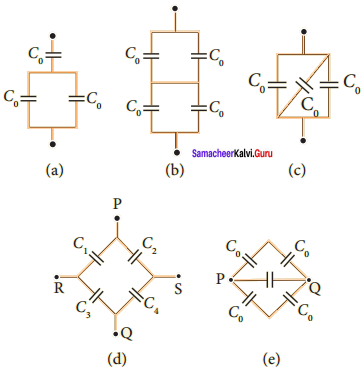
Answer:
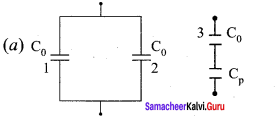
Parallel combination of capacitor 1 and 2
Cp = C0 + C0 = 2C0
Series combination of capacitor Cp and 3
\(\frac { 1 }{{ C }_{S}}\) = \(\frac { 1 }{{ C }_{p}}\) + \(\frac { 1 }{{ C }_{3}}\) = \(\frac { 1 }{{ 2C }_{0}}\) + \(\frac { 1 }{{ C }_{0}}\) = (or) \(\frac { 1 }{{ C }_{S}}\) = \(\frac { 3 }{ 2 }\) C0 (or)CS = \(\frac { 2 }{ 3 }\) C0
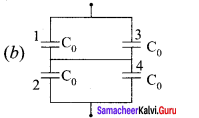
\(\frac { 1 }{ { C }_{ { S }_{ 1 } } } \) = \(\frac { 1 }{{ C }_{1}}\) + \(\frac { 1 }{{ C }_{2}}\) = \(\frac { 1 }{{ C }_{0}}\) + \(\frac { 1 }{{ C }_{0}}\) = \(\frac { 1 }{{ C }_{0}}\) (or)
\(\frac { 1 }{ { C }_{ { S }_{ 1 } } } \) = \(\frac { 2 }{{ C }_{0}}\) (or) \({ C }_{ { S }_{ 1 } }\) = \(\frac {{ C }_{0}}{ 2 }\)
Similarly 3 and 4 are series combination
\(\frac { 1 }{ { C }_{ { S }_{ 2 } } } \) = \(\frac { 1 }{{ C }_{3}}\) + \(\frac { 1 }{{ C }_{4}}\) = \(\frac { 1 }{{ C }_{0}}\) + \(\frac { 1 }{{ C }_{0}}\) = \(\frac { 2 }{{ C }_{0}}\) (or) \({ C }_{ { S }_{ 2 } }\) = \(\frac {{ C }{0}}{ 2 }\)
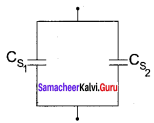
\({ C }_{ { S }_{ 1 } }\) and \({ C }_{ { S }_{ 2 } }\) are in parallel combination
Cp = \({ C }_{ { S }_{ 1 } }\) + \({ C }_{ { S }_{ 2 } }\) = \(\frac {{ C }_{0}}{ 2 }\) + \(\frac {{ C }_{0}}{ 2 }\) (or) Cp = \(\frac {{ 2C }_{0}}{ 2 }\) Cp = C0
(c) Capacitor 1, 2 and 3 are in parallel combination
Cp = C0 + C0 + C0 = 3C0
Cp = 3C0
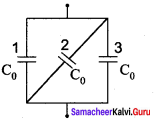
(d) Capacitar C1 and C2 are in combination
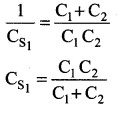
Similarly C3 and C4 are in series combination
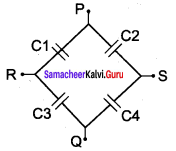
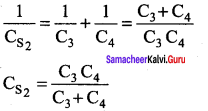
\({ C }_{ { S }_{ 1 } }\) and \({ C }_{ { S }_{ 2 } }\) are in parallel combination across RS:
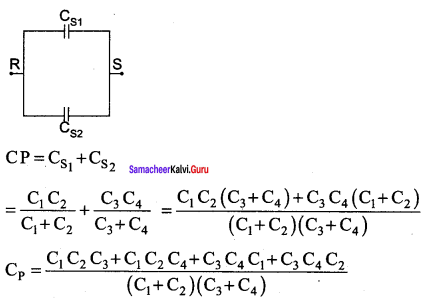
(e) Capacitor 1 and 2 are series combination

Similarly 3 and 4 are series combination
\(\frac { 1 }{ { C }_{ { S }_{ 2 } } } \) = \(\frac { 2 }{{ C }_{0}}\) (or) \({ C }_{ { S }_{ 2 } }\) = \(\frac {{ C }_{0}}{ 2 }\)
Three capacitors are in parallel combination
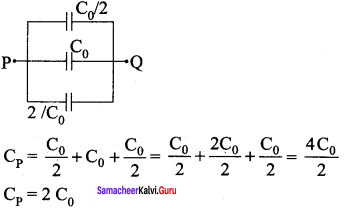
Question 12.
An electron and a proton are allowed to fall through the separation between the plates of a parallel plate capacitor of voltage 5 V and separation distance h = 1 mm as shown in the figure.
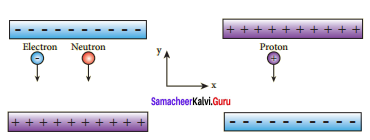
(a) Calculate the time of flight for both electron and proton
(b) Suppose if a neutron is allowed to fall, what is the time of flight?
(c) Among the three, which one will reach the bottom first?
(Take mp = 1.6 x 10-27 kg, me= 9.1 x 10-31 kg and g = 10 m s-2)
Answer:
Potential difference between the parallel plates V = 5 V
Separation distance, h = 1 mm =1 x 10-3 m
Mass of proton, mp = 1.6 x 10-27 kg
Mass of proton, m =9.1 x 10-31 kg
Charge of an a proton (or) electron, e— 1.6 x 10-19 C
[u = 0; s = h]
From equation of motion, S = ut + \(\frac { 1 }{ 2 }\) at2
From equation of motion, h = \(\frac { 1 }{ 2 }\) at2
t = \(\sqrt { \frac { 2h }{ a } } \)
Acceleration of an electron due to electric field, a = \(\frac { F }{ m }\) = \(\frac { eE }{ m }\)
[E = \(\frac { V }{ d }\)]
(a) Time of flight for both electron and proton,
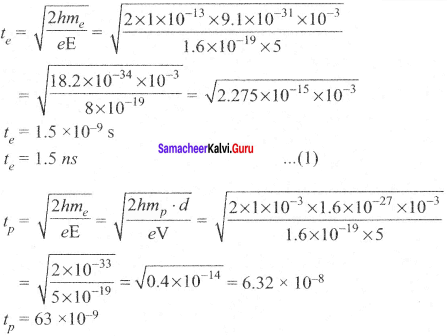
tp = 63 ns……. (2)
(b) time of flight of neutron tn = \(\sqrt { \frac { 2h }{ g } } \) = \(\sqrt{\frac{2 \times 1 \times 10^{3}}{10}}\) = \(\sqrt{0.2 \times 10^{-3}}\)
tn = 0.0141 s = 14.1 x 10-3 s
tn = 14.1 x 10-3 ms ……. (3)
(c) Compairision of values 1,2 and 3. The electron will reach the bottom first.
![]()
Question 13.
During a thunderstorm, the movement of water molecules within the clouds creates friction, partially causing the bottom part of the clouds to become negatively charged. This implies that the bottom of the cloud and the ground act as a parallel plate capacitor. If the electric field between the cloud and ground exceeds the dielectric breakdown of the air (3 x 106 Vm-1 ), lightning will occur.
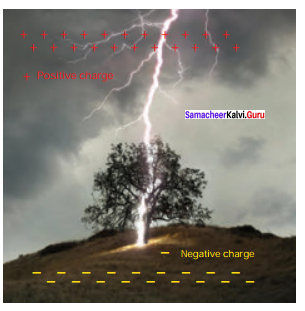
(a) If the bottom part of the cloud is 1000 m above the ground, determine the electric potential difference that exists between the cloud and ground.
(b) In a typical lightning phenomenon, around 25C of electrons are transferred from cloud to ground. How much electrostatic potential energy is transferred to the ground?
Answer:
(a) Electric field between the cloud and ground,
V = E.d
V= 3 x 106 x 1000 = 3 x 109V
(a) Electrons transfered from cloud to ground,
q = 25 C
Electron static potential energy,
U = \(\frac { 1 }{ 2 }\) CV2
[C = \(\frac { q }{ V }\)]
= \(\frac { 1 }{ 2 }\) qV = \(\frac { 1 }{ 2 }\) x 25 x 3 x 109
U = 37.5 x 109 J
Question 14.
For the given capacitor configuration
(a) Find the charges on each capacitor
(b) potential difference across them
(c) energy stored in each capacitor.
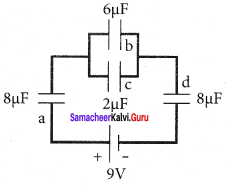
Answer:
Capacitor b and c in parallel combination
Cp = Cb + Cc = (6 + 2) μF = 8 μF
Capacitor a, cp and d are in series combination, so the resulatant copacitance
\(\frac { 1 }{{ C }_{s}}\) = \(\frac { 1 }{{ C }_{a}}\) + \(\frac { 1 }{{ C }_{cp}}\) + \(\frac { 1 }{{ C }_{d}}\) = \(\frac { 1 }{ 8 }\) + \(\frac { 1 }{ 8 }\) + \(\frac { 1 }{ 8 }\) = \(\frac { 3 }{ 8 }\)
Cs = \(\frac { 8 }{ 3 }\) μF

(a) Charge on each capacitor,
Charge on capacitor a, Qa = Cs V = \(\frac { 8 }{ 3 }\) x 9
Qa = 24 μC
Charge on capacitor, d, Qd = Cs V = \(\frac { 8 }{ 3 }\) x 9
Qd = 24 μC
Capacitor b and c in parallel
Charge on capacitor, b, Qb = \(\frac { 6 }{ 3 }\) x 9 = 18
Qb = 18 μC
Charge on capacitor, c, Qc = \(\frac { 2 }{ 3 }\) x 9 = 6
Qc = 6 μC
(b) Potential difference across each capacitor, V = \(\frac { q }{ C }\)
Capacitor Ca, Va = \(\frac{ { q }_{a}}{{ C }_{a}}\) = \(\frac {{ 24 × 10 }^{6}}{{ 8 × 10 }^{6}}\) = 3 V
Capacitor Cb, Vb = \(\frac{ { q }_{b}}{{ C }_{b}}\) = \(\frac {{ 18 × 10 }^{6}}{{ 6 × 10 }^{6}}\) = 3 V
Capacitor Cc, Vc = \(\frac{ { q }_{c}}{{ C }_{c}}\) = \(\frac {{ 6 × 10 }^{6}}{{ 2 × 10 }^{6}}\) = 3 V
Capacitor Cd, Vd = \(\frac{ { q }_{d}}{{ C }_{d}}\) = \(\frac {{ 24 × 10 }^{6}}{{ 8 × 10 }^{6}}\) = 3 V
(c) Energy stores in a capacitor, U = \(\frac { 1 }{ 2 }\) CV2
Energy in capacitor Ca, Ua = \(\frac { 1 }{ 2 }\) Ca \({ V }_{ a }^{ 2 }\) = \(\frac { 1 }{ 2 }\) x 8 x 10-6 x (3)2
Ua = 36 μJ
Capacitor Cb, Ub = \(\frac { 1 }{ 2 }\) Cb \({ V }_{ b }^{ 2 }\) = \(\frac { 1 }{ 2 }\) x 6 x 10-6 x (3)2
Ua = 27 μJ
Cc, Uc = \(\frac { 1 }{ 2 }\) Cc \({ V }_{ c }^{ 2 }\) = \(\frac { 1 }{ 2 }\) x 2 x 10-6 x (3)2
Ua = 9 μJ
Cd, Ud = \(\frac { 1 }{ 2 }\) Cd \({ V }_{ d }^{ 2 }\) = \(\frac { 1 }{ 2 }\) x 8 x 10-6 x (3)2
Ua = 36 μJ
Question 15.
Capacitors P and Q have identical cross-sectional areas A and separation d. The space between the capacitors is filled with a dielectric of dielectric constant as shown in the figure. Calculate the capacitance of capacitors P and Q.
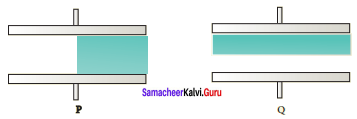
Answer:
Cross-sectional area of parallel plate capacitor = A
Each area of different medium between parallel plate capacitor = \(\frac { A }{ 2 }\)
Separation distance = d
Capacitance of parallel plate capacitor, C = \(\frac { εA }{ d }\)
Air medium of dielectric constant, εr = 1
dielectric medium of dielectric constant = εr
Case 1:
Capacitance of air filled capacitor

Capacitance of dielectric-filled capacitor

Capacitance of parallel plate capacitor

Case 2:
Each distance of different medium between the parallel plate capacitor = \(\frac { d }{ 2 }\)
Capacitance of dielectric-filled capacitor

Capacitance of air filled capacitor,

Capacitance of parallel plate capacitor,
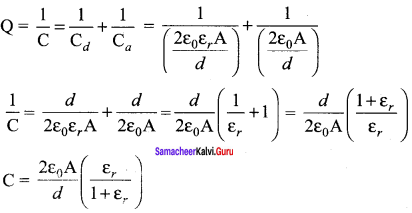
Samacheer Kalvi 12th Physics Electrostatics Additional Questions Solved
I. Multiple Choice Questions
Question 1.
When a solid body is negatively charged by friction, it means that the body has
(a) acquired excess of electrons
(b) lost some, problems
(c) acquired some electrons and lost a lesser number of protons
(d) lost some positive ions
Answer:
(a) acquired excess of electrons
Question 2.
A force of 0.01 N is exerted on a charge of 1.2 x 10-5 G at a certain point. The electric field at that point is
(a) 5.3 x 104 NC-1
(b) 8.3 x 10-4 NC-1
(c) 5.3 x 102 NC-1
(d) 8.3 x 104 NC-1
Answer:
(d) 8.3 x 104 NC-1
Hint:
E = \(\frac { F }{ q }\) = \(\frac { 0.01 }{{ 1.2 × 10 }^{-5}}\) = 8.3 x 102 NC-1
Question 3.
The electric field intensity at a point 20 cm away from a charge of 2 x 10 5 C is
(a) 4.5 x 106 NC-1
(b) 3.5 x 105 NC-1
(c) 3.5 x 106 NC-1
(d) 4.5 x 105 NC-1
Answer:
(a) 4.5 x 106 NC-1
Hint:
E = \(\frac{q}{4 \pi \varepsilon_{0} r^{2}}\) = \(\frac{9 \times 10^{9} \times 2 \times 10^{-5}}{(0.2)^{2}}\) = 4.5 x 106 NC-1
Question 4.
How many electrons will have a charge of one coulomb?
(a) 6.25 x 1018
(b) 6.25 x 1019
(c) 1.6 x 1018
(d) 1.6 x 1019
Answer:
(a) 6.25 x 1018
Hint:
Number of electron, n = \(\frac { q }{ e }\) = \(\frac { 1 }{{ 1.6 × 10 }^{-19}}\) = 6.25 × 1018
Question 5.
The ratio of the force between two charges in air and that in a medium of dielectric constant K is
(a) K : 1
(b) 1 : K
(c) K2 : 1
(d) 1 : K2
Answer:
(a) K : 1
![]()
Question 6.
The work done in moving a positive charge on an equipotential surface is
(a) finite and positive
(b) infinite
(c) finite and negative
(d) zero
Answer:
(d) zero
Question 7.
If a charge is moved against the Coulomb force of an electric field.
(a) work is done by the electric field
(b) energy is used from some outside source
(c) the strength of the field is decreased
(d) the energy of the system is decreased
Answer:
(b) energy is used from some outside source
Question 8.
No current flows between two charged bodies when connected
(a) if they have the same capacitance
(b) if they have the same quantity of charge
(c) if they have the same potential
(d) if they have the same charge density
Answer:
(c) if they have the same potential
Question 9.
Electric field lines about a negative point charge are
(a) circular, anticlockwise
(b) circular, clockwise
(c) radial, inwards
(d) radial, outwards
Answer:
(c) radial, inwards
Question 10.
Two plates are 1 cm apart and the potential difference between them is 10 V. The electric field between the plates is
(a) 10 NC-1
(b) 250 NC-1
(c) 500 N-1
(d) 1000 NC-1
Answer:
(d) 1000 NC-1
Hint:
E = \(\frac { V }{ d }\) = \(\frac { 10 }{{ 1 × 10 }^{-2}}\) = 8.3 x 102 NC-1
![]()
Question 11.
At a large distance (r), the electric field due to a dipole varies as
(a) \(\frac { 1 }{ r }\)
(b) \(\frac { 1 }{{ r }^{2}}\)
(c) \(\frac { 1 }{{ r }^{3}}\)
(d) \(\frac { 1 }{{ r }^{4}}\)
Answer:
(c) \(\frac { 1 }{{ r }^{3}}\)
Question 12.
Two thin infinite parallel plates have uniform charge densities +c and -σ. The electric field in the space between then is
(a) \(\frac { σ }{{ 2ε }_{0}}\)
(b) \(\frac { σ }{{ ε }_{0}}\)
(c) \(\frac { 2σ }{{ 2ε }_{0}}\)
(d) Zero
Answer:
(b) \(\frac { σ }{{ ε }_{0}}\)
Question 13.
Two isolated, charged conducting spheres of radii R1, and R2 produce the same electric field near their surfaces. The ratio of electric potentials on their surfaces is-
(a) \(\frac {{ R }_{1}}{{ R }_{2}}\)
(b) \(\frac {{ R }_{2}}{{ R }_{1}}\)
(c) \(\frac { { R }_{ 1 }^{ 2 } }{ { R }_{ 2 }^{ 2 } } \)
(d) \(\frac { { R }_{ 2 }^{ 2 } }{ { R }_{ 1 }^{ 2 } } \)
Answer:
(b) \(\frac {{ R }_{2}}{{ R }_{1}}\)
Question 14.
A 100 μF capacitor is to have an energy content of 50 J in order to operator a flash lamp. The voltage required to charge the capacitor is
(a) 500 V
(b) 1000 V
(c) 1500 V
(d) 2000 V
Answer:
(b) 1000 V
Hint:

Question 15.
A 1 μF capacitor is placed in parallel with a 2 μF capacitor across a 100 V supply. The total charge on the system is
(a) \(\frac { 100 }{ 3 }\) μC
(b) 100 μC
(c) 150 μC
(d) 300 μC
Answer:
(d) 300 μC
Hint:
Equivalent capacitor = 1 + 2 = 3 μF
Total charge, q = CV = 3 x 100 = 300 μF
![]()
Question 16.
A parallel plate capacitor of capacitance 100 μF is charged to 500 V. The plate separation is then reduced to half its original value. Then the potential on the capacitor becomes
(a) 250 V
(b) 500 V
(c) 1000V
(d) 2000 V
Answer:
(a) 250 V
Hint:
Here, C’ = 2C, since the charge remains the same.
q = C’V’ = CV ⇒ V = \(\frac { CV }{ 2C }\) = \(\frac { 500 }{ 2 }\) = 250 V
Question 17.
A point charge q is placed at the midpoint of a cube of side L. The electric flux emerging from the cube is ‘
(a) \(\frac { q }{{ ε }_{0}}\)
(b) \(\frac { q }{{ 6Lε }_{0}}\)
(c) \(\frac { 6Lq }{{ ε }_{0}}\)
(d) zero
Answer:
(a) \(\frac { q }{{ ε }_{0}}\)
Question 18.
The capacitor C of a spherical conductor of radius R is proportional to
(a) R2
(b) R
(c) R-1
(d) R0
Answer:
(b) R
Question 19.
Energy of a capacitor of capacitance C, when subjected to a potential V, is given by
(a) \(\frac { 1 }{ 2 }\) CV2
(b) \(\frac { 1 }{ 2 }\) C2V
(c) \(\frac { 1 }{ 2 }\) CV
(d) \(\frac { 1 }{ 2 }\) \(\frac { C }{ V }\)
Answer:
(a) \(\frac { 1 }{ 2 }\) CV2
Question 20.
The electric field due to a dipole at a distance r from its centre is proportional to
(a) \(\frac { 1 }{{ r }^{3/2}}\)
(b) \(\frac { 1 }{{ r }^{3}}\)
(c) \(\frac { 1 }{ r }\)
(d) \(\frac { 1 }{{ r }^{3}}\)
Answer:
(b) \(\frac { 1 }{{ r }^{3}}\)
![]()
Question 21.
A point charge q is rotating around a charge Q in a circle of radius r. The work done on it by the Coulomb force is
(a) 2πrq
(b) 2πQq
(c) \(\frac { Q }{{ 2ε }^{0}r}\)
(d) zero
Answer:
(d) zero
Question 22.
The workdone in rotating an electric dipole of moment P in an electric field E through an angle 0 from the direction of the field is
(a) pE (1 – cos θ)
(b) 2pE
(c) zero
(d) -pE cos θ
Answer:
(a) pE (1 – cos θ)
Hint:
W = pE(cos θ0 – cos θ)
[θ0 = cos 0, cos 0 = 1]
W = pE(1 – cos θ)
Question 23.
The capacitance of a parallel plate capacitor can be increased by
(a) increasing the distance between the plates
(b) increasing the thickness of the plates
(c) decreasing the thickness of the plates
(d) decreasing the distance between the plates
Answer:
(d) decreasing the distance between the plates
Question 24.
Two charges are placed in vacuum at a distance d apart. The force between them is F. If a medium of dielectric constant 2 is introduced between them, the force will now be
(a) 4F
(b) 2F
(c) F/2
(d) F/4
Answer:
(d) F/4
Question 25.
An electric charge is placed at the centre of a cube of side a. The electric flux through one of its faces will be
(a) \(\frac { q }{{ 6ε }^{0}}\)
(b) \(\frac { q }{ { ε }_{ 0 }{ a }^{ 2 } } \)
(c) \(\frac { q }{ { 4πε }_{ 0 }{ a }^{ 2 } } \)
(a) \(\frac { q }{{ ε }^{0}}\)
Answer:
(a) \(\frac { q }{{ 6ε }^{0}}\)
Hint:
According to Gauss’s law, the electric flux through the cube is \(\frac { q }{{ ε }^{0}}\). Since there are six faces, the flux through one face is \(\frac { q }{{ 6ε }^{0}}\).
![]()
Question 26.
The electric field in the region between two concentric charged spherical shells-
(a) is zero
(b) increases with distance from centre
(c) is constant
(d) decreases with distance from centre
Answer:
(d) decreases with distance from centre
Question 27.
A hollow metal sphere of radius 10 cm is charged such that the potential on its surface is 80V. The potential at the centre of the sphere is-
(a) 800 V
(b) zero
(c) 8 V
(d) 80 V
Answer:
(d) 80 V
Question 28.
A 4 μF capacitor is charged to 400 V and then its plates are joined through a resistance of 1 K Ω. The heat produced in the resistance is-
(a) 0.16 J
(b) 0.32 J
(c) 0.64 J
(d) 1.28 J
Answer:
(b) 0.32 J
Hint:
The energy stored in capacitor is converted into heat
U = H = \(\frac { 1 }{ 2 }\) CV2 = \(\frac { 1 }{ 2 }\) x 4 x 10-6 x (400)2 = 0.32 J
Question 29.
The work done in carrying a charge Q, once round a circle of radius R with a charge Q2 at the centre is-
(a) \(\frac{\mathrm{Q}_{1} \mathrm{Q}_{2}}{4 \pi \varepsilon_{0} \mathrm{R}^{2}}\)
(b) zero
(c) \(\frac{\mathrm{Q}_{1} \mathrm{Q}_{2}}{4 \pi \varepsilon_{0} \mathrm{R}}\)
(d) infinite
Answer:
(b) zero
Hint:
The electric field is conservative. Therefore, no work is done in moving a charge around a closed path in an electric field.
Question 30.
Two plates are 2 cm apart. If a potential difference of 10 V is applied between them. The electric field between the plates will be
(a) 20 NC-1
(b) 500 NC-1
(c) 5 NC-1
(d) 250 NC-1
Answer:
(b) 500 NC-1
Hint:
\(\frac { V }{ d }\) = \(\frac { 10 }{{ 2 ×10 }^{-2}}\) 500 NC-1
![]()
Question 31.
The capacitance of a parallel plate capacitor does not depend on
(a) area of the plates
(b) metal of the plates
(c) medium between the plates
(d) distance between the plates
Answer:
(b) metal of the plates
Question 32.
A capacitor of 50 μF is charged to 10 volts. Its energy in joules is
(a) 2.5 x 10-3
(b) 5 x 10-3
(c) 10 x 10-4
(d) 2.5 x 10-4
Answer:
(a) 2.5 x 10-3
Hint:
U = \(\frac { 1 }{ 2 }\) CV2 = \(\frac { 1 }{ 2 }\) x 50 x 10-6 x (10)2 = 2.5 x 10-3 J
Question 33.
A cube of side b has a charge q at each of its vertices. The electric field due to this charge distribution at the centre of the cube is
(a) \(\frac { q }{{b}^{ 2 }}\)
(b) \(\frac { q }{{2b}^{ 2 }}\)
(c) \(\frac { 32q }{{b}^{ 2 }}\)
(d) zero
Answer:(d) zero
Hint:
There
is an equal charge at diagonally opposite comer. The fields due the these at the centre cancel out. Therefore, the net field at the centre is zero.
Question 34.
Total electric fulx coming out of a unit positive charge put in air is
(a) ε0
(b) \({ \varepsilon }_{ 0 }^{ -1 }\)
(c) (4πε0)-1
(d) 4πε0
Answer:
(b) \({ \varepsilon }_{ 0 }^{ -1 }\)
Question 35.
Electron volt (eV) is a unit of
(a) energy
(b) potential
(c) current
(d) charge
Answer:
(a) energy
Question 36.
A point Q lies on the perpendicular bisector of an electric dipole of dipole moment P. If the distance of Q from the dipole is r, then the electric field at Q is proportional to-
(a) p-1 and r-2
(b) p and r-2
(c) p and r-3
(d) p2 and r-3
Answer:
(c) p and r-3
Question 37.
A hollow insulated conducting sphere is given a positive charge of 10 μC. What will be the electric field at the centre of the sphere is its radius is 2 metres?
(a) zero
(b) 8 μCm-2
(c) 20 μCm-2
(d) 5 μCm-2
Answer:
(d) zero
Question 38.
A particle of charge q is placed at rest in a uniform electric field E and then released. The kinetic energy attained by the particle after moving a distance y is-
(a) qE2y
(b) q2Ey
(c) qEy2
(d) qEy
Answer:
(d) qEy
Hint:
Force on the particle = qE
KE = Work done by the force = F.y = qEy
Question 39.
Dielectric constant of metals is-
(a) 1
(b) greater then 1
(c) zero
(d) infinite
Answer:
(d) infinite
Question 40.
When a positively charged conductor is earth connected
(a) protons flow from the conductor to the earth
(b) electrons flow from the earth to the conductor
(c) electrons flow from the conductor to the earth
(d) no charge flow occurs
Answer:
(b) electrons flow from the earth to the conductor
![]()
Question 41.
The SI unit of electric flux is
(a) volt metre2
(b) newton per coulomb
(c) volt metre
(d) joule per coulomb
Answer:
(c) volt metre
Question 42.
Twenty seven water drops of the same size are charged to the same potential. If they are combined to form a big drop, the ratio of the potential of the big drop to that of a small drop is-
(a) 3
(b) 6
(c) 9
(d) 27
Answer:
(c) 9
Hint:
V’ = n2/3 V
⇒ \(\frac { V’ }{ V }\) = (27)2/3 = 9
Question 43.
A point charge +q is placed at the midpoint of a cube of side l. The electric flux emerging ’ from the cube is-
(a) \(\frac { q }{{ ε }^{0}}\)
(b) \(\frac {{ 6ql }^{2}}{{ ε }^{0}}\)
(c) \(\frac { q }{ { 6l }^{ 2 }{ { ε }^{ 0 } } } \)
(d) \(\frac { { C }^{ 2 }{ V }^{ 2 } }{ 2 } \)
Answer:
(a) \(\frac { q }{{ ε }^{0}}\)
Question 44.
The energy stored in a capacitor of capacitance C, having a potential difference V between the plates, is-
Answer:
(c)
Question 45.
The electric potential at the centre of a charged conductor is-
(a) zero
(b) twice that on the surface
(c) half that on the surface
(d) same as that on the surface
Answer:
(d) same as that on the surface
Question 46.
The energy stored in a capacitor is given by
(a) qV
(b) \(\frac { 1 }{ 2 }\)qV
(c) \(\frac { 1 }{ 2 }\) CV
(d) \(\frac { q }{ 2C }\)
Answer:
(b) \(\frac { 1 }{ 2 }\)qV
![]()
Question 47.
The unit of permitivity of free space so is
(a) coulomb/newton-metre
(b) newton-metre2/coulomb2
(c) coulomb2/newton-metre2
(d) coulomb/(newton-metre)2
Answer:
(c) coulomb2/newton-metre2
Question 48.
An electric dipole has the magnitude of its charge as q and its dipole moment is p. It is placed in a uniform electric field E. If its dipole moment is along the direction of the field, the force on it and its potential energy are, respectively.
(a) 2qE and minimum
(b) qE and pE
(c) zero and minimum
(d) qE and maximum
Answer:
(c) zero and minimum
Hint:
Potential energy, U = -pE cos θ
For q = 0°; U = -pE, which is minimum.
Question 49.
An electric dipole of moment \(\vec { P } \) is lying along a uniform electric field \(\vec { E } \) . The workdone in rotating the dipole by 90° is
(a) \(\frac { pE }{ 2 }\)
(b) 2pE
(c) pE
(d) √2pE
Answer:
(c) pE
Question 50.
A parallel plate air capacitor is charged to a potential difference of V volts. After disconnecting the charging battery the distance between the plates of the capacitor is increased using an insulating handle. As a result the potential difference between the plates
(a) does not charge
(b) becomes zero
(c) increases
(d) decreases
Answer:
(c) increases
Question 51.
When air is replaced by a dielectric medium of constant K, the maximum force of attraction between two charges separated by a distance
(a) increases K times
(b) increases K-1 times
(c) decreases K times
(d) remains constant
Answer:
(c) decreases K times
Question 52.
A comb runs through one’s dry hair attracts small bits of paper. This is due to the fact that
(a) comb is a good conductor
(b) paper is a good conductor
(c) the atoms in the paper get polarised by the charged comb
(d) the comb posseses magnetic properties
Answer:
(c) the atoms in the paper get polarised by the charged comb
![]()
Question 53.
Which of the following is not a property of equipotential surfaces?
(a) they do not cross each other
(b) they are concentric spheres for uniform electric field
(c) the rate of change of potential with distance on them is zero
(d) they can be imaginary spheres.
Answer:
(b) they are concentric spheres for uniform electric field
Question 54.
A charge Q is enclosed by a Gaussian spherical surface of radius R. If the radius is doubled, then the outward electric flux will be
(a) reduced to half
(b) doubled
(c) becomes 4 times
(d) remains the same
Answer:
(d) remains the same
Question 55.
If the electric field in a region is given by \(\vec { E } \) = 5\(\hat{j} \) + 4\(\hat{j} \) + 9\(\hat{k} \) , then the electric flux through a surface of area 20 units lying in the y-z plane will be-
(a) 20 units
(b) 80 units
(c) 100 units
(d) 180 units
Answer:
(c) 100 units
Hints:
The area vector \(\vec { A } \) = 20\(\hat{j} \); \(\vec { E } \) = (5\(\hat{j} \) + 4\(\hat{j} \) + 9\(\hat{k} \))
Flux (Φ) = \(\vec { E } \) – \(\vec { A } \) = 5 x 20 =100 units
Question 56.
A, B and C are three points in a uniform electric field. The electric potential is-

(a) maximum at A
(b) maximum at B
(c) maximum at B
(d) same at all the three points A, B, and C
Answer:
(b) maximum at B
Hint:
The potential decreases in the direction of the field. Therefore VB > VC>CA.
Question 57.
A conducting sphere of radius R is give a charge Q. The electric potential and the electric field at the centre of the sphere are, respectively-
(a) zero, \(\frac { Q }{ { 4\pi ε }_{ 0 }{ R }^{ 2 } } \)
(b) \(\frac { Q }{ { 4\pi ε }_{ 0 }{ R } } \)
(c) \(\frac { Q }{ { 4\pi ε }_{ 0 }{ R } } \), zero
(d) zero,zero
Answer:
(c) \(\frac { Q }{ { 4\pi ε }_{ 0 }{ R } } \), zero.
II. Fill in the blanks
Question 1.
A dipole is placed in a uniform electric field with its axis parallel to the field. It experiences …………………
Answer:
neither a net force nor a torque
Question 2.
The unit of permittivity is…………………
Answer:
C2N-1m-2
Question 3.
The branch of physics which deals with static electric charges or charges at rest is …………………
Answer:
electrostatics
Question 4.
The charges in an electrostatic field are analogous to ………………… in a gravitational field.
Answer:
mass
![]()
Question 5.
The substances which acquire charges on rubbing are said to be …………………
Answer:
electrified
Question 6.
Electron means …………………
Answer:
amber
Question 7.
A glass rod rubbed with a silk cloth. Glass rod and silk cloth acquire…………………
Answer:
positive and negative charge respectively
Question 8.
When ebonite rod is rubbed with fur, ebonite rod and fur acquires …………………
Answer:
negative and positive charge respectively
Question 9.
………………… termed the classification of positive and negative charges.
Answer:
Franklin
Question 10.
Applications such as electrostatic point spraying and powder coating, are based on the property of ………………… between charged bodies.
Answer:
attraction and repulsion
Question 11.
Bodies which allow the charge to pass through them are called …………………
Answer:
conductor
Question 12.
Bodies which do not allow the charge to pass through them are called …………………
Answer:
insulators
Question 13.
The unit of electric charge is …………………
Answer:
coulomb
Question 14.
Total charge in an isolated system …………………
Answer:
remains a constant
Question 15.
The force between two charged bodies was studied by …………………
![]()
Answer:
coulomb
Question 16.
The unit of permittivity in free space (s0) is …………………
Answer:
C2N-1m-2
Question 17.
The value of s, for air or vacuum is …………………
Answer:1
Question 18.
Charges can neither be created nor be destroyed is the statement of the law of conservation of …………………
Answer:
charge
Question 19.
The space around the test charge, in which it experiences a force is known as field …………………
Answer:
electric
Question 20.
Electric field at a point is measured in terms of …………………
Answer:
electric field intensity
Question 21.
The unit of electric field intensity is …………………
Answer:
NC-1.
Question 22.
The lines of force are far apart, when electric field E is …………………
Answer:
small
Question 23.
The lines of force are close together when electric field E is …………………
Answer:
large
Question 24.
Electric dipole moment …………………
Answer:
P = 2qd
Question 25.
Torque experienced by electric dipole is …………………
Answer:
x = PE sin θ
Question 26.
An electric dipole placed in a non-uniform electric field at an angle θ experiences …………………
Answer:
both torque and force
![]()
Question 27.
When thee dipole is aligned parallel to the field, its electric potential energy is …………………
Answer:
u = -PE
Question 28.
Change of potential with distance is known as …………………
Answer:
potential distance
Question 29.
The number of electric lines of force crossing through the given area is …………………
Answer:
electric flux
Question 30.
The process of isolating a certain region of space from the external field is called …………………
Answer:
electrostatic shielding
Question 31.
A capacitor is a device to store …………………
Answer:
charge
Question 32.
The charge density in maximum at …………………
Answer:
pointed
Question 33.
The principle made use of lightning arrestor is …………………
Answer:
action of points
Question 34.
Van de Graaff generator producers large electrostatic potential difference of the order of …………………
Answer:
107 V
III. Match the following
Question 1.
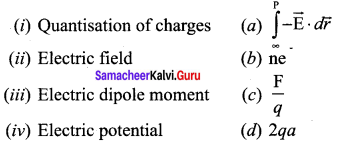
Answer:
(i) → (d)
(ii) → (a)
(iii) → (b)
(iv) → (c)
Question 2.

Answer:
(i) → (c)
(ii) → (d)
(iii) → (a)
(iv) → (b)
Question 3.

Answer:
(i) → (b)
(ii) → (d)
(iii) → (a)
(iv) → (c)
Question 4.

Answer:
(i) → (b)
(ii) → (d)
(iii) → (a)
(iv) → (c)
IV. Assertion and reason type
(a) If both assertion and reason are true and the reason is the correct explanation of the assertion.
(b) If both assertion and reason are true but the reason is not correct explanation of the assertion.
(c) If the assertion is true but the reason is false.
(d) If the assertion and reason both are false.
(e) If the assertion is false but the reason is true.
Question 1.
Assertion: Electric lines of force cross each other.
Reason: Electric field at a point superimposed to give one resultant electric field.
Answer:
(e) Both assertion and reason are true but the reason is not the correct explanation of the assertion.
Explanation: If electric lines of forces cross each other, then the electric field at the point of intersection will have two directions simultaneously which is not possible physically.
Question 2.
Assertion: Charge is quantized.
Reason: Charge, which is less than 1 C is not possible.
Answer:
(c) If assertion is true but reason is false.
Explanation: Q = ±ne and charge lesser than 1 C is possible.
![]()
Question 3.
Assertion:
A point charge is brought in an electric field. The field at a nearby point will increase, whatever be the nature of the charge.
Reason: The electric field is independent of the nature of the charge.
(d) If the assertion and reason both are false.
Explanation: Electric field at the nearby-point will be resultant of the existing field and field due to the charge brought. It may increase or decrease if the charge is positive or negative depending on the position of the point with respect to the charge brought.
Question 4.
Assertion: The tyre’s of aircraft are slightly conducting.
Reason: If a conductor is connected to the ground, the extra charge induced on the conductor will flow to the ground.
Answer:
(b) Both assertion and reason are true but the reason is not the correct explanation of the assertion.
Explanation: During take-off and landing, the friction between treys and the runway may cause electrification of treys. Due to conducting to a ground and election sparking is avoided.
Question 5.
Assertion: The lightning conductor at the top of a high building has sharp ends.
Reason: The surface density of charge at sharp points is very high, resulting in the setting up of electric wind.
Answer:
(a) Both assertion and reason are true and the reason is the correct explanation of the assertion.
Samacheer Kalvi 12th Physics Electrostatics Short Answer Questions
Question 1.
What is meant by triboelectric charging?
Answer:
Charging the objects through rubbing is called triboelectric charging.
Question 2.
What is meant by the conservation of total charges?
Answer:
The total electric charge in the universe is constant and the charge can neither be created nor be destroyed. In any physical process, the net change in charge will always be zero.
Question 3.
State Gauss’s Law?
Answer:
Definition:
Gauss’s law states that if a charge Q is enclosed by an arbitrary closed surface, then the total electric flux OE through the closed surface is
ΦE = \(\oint { \vec { E } } \) .d\(\vec { A } \) = \(\frac {{ q }_{encl}}{{ ε }_{0}}\)
![]()
Question 4.
What is meant by electrostatic shielding?
During lightning accompanied by a thunderstorm, it is always safer to sit inside a bus than in open ground or under a tree. The metal body of the bus provides electrostatic shielding, since the electric field inside is zero. During lightning, the charges flow through the body of the conductor to the ground with no effect on the person inside that bus.
Question 5.
What is meant by dielectric?
Answer:
A dielectric is a non-conducting material and has no free electrons. The electrons in a dielectric are bound within the atoms. Ebonite, glass and mica are some examples of dielectrics.
Question 6.
What are non-polar molecules? Give examples.
A non-polar molecule is one in which centers of positive and negative charges coincide. As a result, it has no permanent dipole moment. Examples of non-polar molecules are hydrogen (H2), oxygen (O2), and carbon dioxide (CO2) etc.
Question 7.
What are polar molecules? Give examples.
Answer:
In polar molecules, the centers of the positive and negative charges are separated even in the absence of an external electric field. They have a permanent dipole moment.
The net dipole moment is zero in the absence of an external electric field. Examples of polar molecules are H2O, N2O, HCl, NH3.
Question 8.
What is a capacitor?
Answer:
A capacitor is a device used to store electric charge and electrical energy. Capacitors are widely used in many electronic circuits and have applications in many areas of science and technology.
Samacheer Kalvi 12th Physics Electrostatics Long Answer Questions
Question 1.
Derive an expression for the electric field due to the system of point charges?
Answer:
Electric field due to the system of point charges:
Suppose a number of point charges are distributed in space. To find the electric field at some point P due to this collection of point charges, the superposition principle is used. The electric field at an arbitrary point due to a collection of point charges is simply equal to the vector sum of the electric fields created by the individual point charges. This is called the superposition of electric fields.
Consider a collection of point charges q1, q2, q3,…., qn located at various points in space. The ‘ total electric field at some point P due to all these n charges is given by

Here r1p, r2p, r3p,…., rnp, are the distance of the charges 1, q2, q3,…., qn from the point respectively. Also \(\hat{r} \)1p + \(\hat{r} \)2p + \(\hat{r} \)3p,…., \(\hat{r} \)np are the corresponding unit vectors directed from q1, q2, q3,…., qn tpo P.
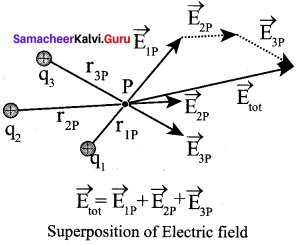
Equation (2) can be re-written as,

For example in figure, the resultant electric field due to three point charges q1, q2, q3 at point P is shown. Note that the relative lengths of the electric field vectors for the charges depend on relative distantes of the charges to the point P.
![]()
Question 2.
Derive an expression for the electric flux of rectangular area placed in a uniform electric field.
Answer:
(i) Electric flux for uniform Electric field:
Consider a uniform electric field in a region of space. Let us choose an area A normal to the electric field lines as shown in figure (a). The electric flux for this case is
ΦE = EA ….. (1)
Suppose the same area A is kept parallel to the uniform electric field, then no electric field lines pierce through the area A, as shown in figure (b). The electric flux for this case is zero.
ΦE = 0 ….. (2)
If the area is inclined at an angle θ with the field, then the component of the electric field perpendicular to the area alone contributes to the electric flux. The electric field component parallel to the surface area will not contribute to the electric flux. This is shown in figure (c). For this case, the electric flux
ΦE = (E cosθ) A …(3)
Further, θ is also the angle between the electric field and the direction normal to the area. Hence in general, for uniform electric field, the electric flux is defined as
ΦE= \(\vec { E } \).\(\vec { A } \) = EA cos θ …(4)
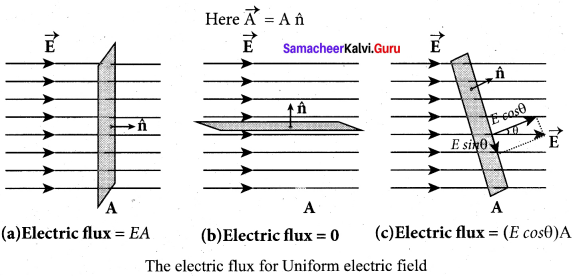
Here, note that \(\vec { A } \) is the area vector \(\vec { A } \) = A\(\hat{n} \). Its magnitude is simply the area A and the direction is along the unit vector h perpendicular to the area. Using this definition for flux, ΦE= \(\vec { E } \).\(\vec { A } \), equations (2) and (3) can be obtained as special cases.
In figure (a), θ = 0° so ΦE= \(\vec { E } \).\(\vec { A } \) = EA
In figure (b), θ = 90° so ΦE= \(\vec { E } \).\(\vec { A } \) = 0
(ii) Electric flux in a non uniform electric field and an arbitrarily shaped area: Suppose the electric field’is not uniform and the area A is not flat, then the entire area is divided
into n small area segments ∆\(\vec { A } \)1 ∆\(\vec { A } \)2, ∆\(\vec { A } \)3,…..∆\(\vec { A } \)n, such that each area element is almost flat and the electric field over each area element is considered to be uniform.
The electric flux for the entire area A is approximately written as

By taking the limit ∆\(\vec { A } \)1 → 0 (for all i) the summation in equation (5) becomes integration. The total electric flux for the entire area is given by
ΦE = ∫\(\vec { E } \).d\(\vec { A } \) ….. (6)
From Equation (6), it is clear that the electric flux for a given surface depends on both the electric field pattern on the surface area and the orientation of the surface with respect to the electric field.
(iii) Electric flux for closed surfaces: In the previous section, the electric flux for any arbitrary curved surface is discussed. Suppose a closed surface is present in the region of the non-uniform electric field as shown in figure (a).
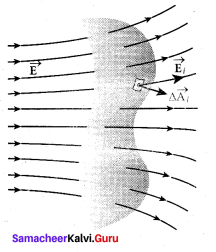
The total electric flux over this closed surface is written as
ΦE = \(\oint { \vec { E } } \).d\(\vec { A } \) …… (7)
Note the difference between equations (6) and (7). The integration in equation (7) is a closed surface integration and for each areal element, the outward normal is the direction of d\(\vec { A } \) as shown in figure (b).
The total electric flux over a closed surface can be negative,
positive or zero. In figure (b), it is shown that in one area element, the angle between d\(\vec { A } \) and \(\vec { E } \) is less than 90°, then the electric flux is positive and in another areal element, the angle between dA and E is greater than 90°, then the electric flux is negative. In general, the electric flux is negative if the electric field lines enter the closed surface and positive if the electric field lines leave the closed surface.

Samacheer Kalvi 12th Physics Electrostatics Numerical Problems
Question 1.
Electrons are caused to fall through a potential difference of 1500 volts. If they were initially at rest. Then calculate their final speed.
Solution:
The electrical potential energy is converted into kinetic energy. If v is the final speed then

Question 2.
Small mercury drops of the same size are charged to the same potential V. If n such drops coalesce to form a single large drop, then calculate its potential.
Solution:
Let r be the radius of a small drop and R that of the large drop. Then, since the volume remains conserved,
\(\frac { 1 }{ 2 }\) πR2 = \(\frac { 4 }{ 3 }\) πR3n
⇒ R3 = r3n
R = r3(n)1/3
Further, since the total charge remains conserved, we have, using Q = CV
Clarge V = n Csmall v
Where V is the potential of the large drop.
4πε0 RV = n (4πε0r)v
V = \(\frac { nrv }{ R }\) = \(\frac { nrv }{{ r(n) }^{1/3}}\)
V = vn2/3
![]()
Question 3.
Two particles having charges Q1 and Q2 when kept at a certain distance, exert a force F on each other. If the distance between the two particles is reduced to half and the charge on each particle is doubled. Find the force between the particles.
Solution:
F = \(\frac { 1 }{{ 4πε }_{0}}\) \(\frac{\mathrm{Q}_{1} \mathrm{Q}_{2}}{r^{2}}\)
If the distance is educed by half and two particles of charges are doubled.
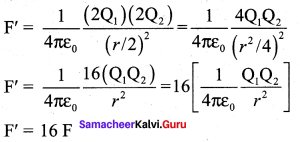
Question 4.
Two charged spheres, separated by a distance d, exert a force F on each other. If they are immersed in a liquid of dielectric constant 2, then what is the force.
Solution:
Force between the charges (vacuum)
![]()
Force between the charges (medium)
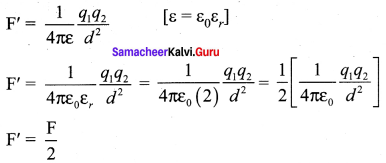
Question 5.
Find the force of attraction between the plates of a parallel plate capacitor.
Solution:
Let d be the distance between the plates. Then the capacitor is
C = \(\frac { { \varepsilon }_{ 0 }A }{ d } \)
Energy stored in a capacitor,

Energy magnitude of the force is,
